CHRONICLES
ACADEMIA AND BEYOND
S M RUMMAN MASHRUR CHOWDHURY UUN :S2589657
Architect, Academician, Researcher Associate Member, IAB(Institute of Architects Bangladesh)
Nationality Bangladeshi
Date of Birth: 01 september, 1991
CONTACT
mashrur.rumman@gmail.com rumman.arch@uap-bd.edu
+8801819170733
House -140/B, Rd 22, Mohakhali DOHS, Dhaka, Bangladesh https://www.linkedin.com/in/s-m-rumman-mashrurchowdhury-69b205265/
https://www.facebook.com/RummanMashrur https://www.facebook.com/Chorcha.Sthapatijog
https://www.facebook.com/pluralworks
WORK EXPERIENCE
Lecturer, Department of Architecture, University of Asia Pacific
• Design Studio Lead :
Studio VI (Verical Urban assemblege, Neo Normal Urban Verticals)
Studio V (Memoirs 1971: Museum, Repurposing Urban Utility Heritages)
Studio III (Master in situ : A Hide Out)
• Thesis Supervisor :
Revitaling Mohammadpur Old Town Hall market, Dhaka.
Extention and Restoration of Gandhi Ashram, Noakhali.
Rethinking A Cultural Heritage the Largest Mango Market in Bangladesh.
Restoration and Adaptive Reuse of Nilkuthi : A Journey to the Colonial Past
Future of the War Refugees Camp at Mohammadpur, Dhaka.
• Theory Construction Details and Methods and Sessional : Working Drawing II
• Advisor : Central Literature Club, 2019-2020
• Design Team Lead, UAP Students’ Cafe
• Member, University Branding Committee.
Lecturer, Department of Architecture, Daffodil International University
PUBLICATIONS / EXHIBITIONS
• Project Hydropod published in the online periodical Habitat by The Business Standard (2022) ( https://www.tbsnews.net/features/habitat/hydro-podplayscape-among-clouds-twist-393078)
• Awarded Entry “Cathersis in petrichor” published in the book “At Point Zero” by Archtwist (https://www.archtwist.com/publication/) and exhibited at Alliance Française de Dhaka (2022).
• Paper on “Remodeling an underground water reservoir prototype infusing new purposes as a sustainable design strategy for hilly area ” published in IDRC 2020 (International Design Research Conference)
• Awarded entry published in “KLAF 2019” [ a publication on “International Design Competition - Tropical House For Orang Asli” organized by PAM (Malaysian Institute of Architects)
• B.Arch thesis project “ Urban Matrix : Central Cultural Precinct in the convergence of Cultural Corridors, Chittagong” was published in “Epilogue 09 : Ideas, Expo, Projects” , Published by DOA, BUET (2017)
• B.Arch thesis project selected for exhibition at “Smart City Innovation Hub 2017 Co-creating Cities” at Bangabandhu Novo-theatre hall, Dhaka.
• Awarded national competition entries exhibited at the Institute of Architects, Bangladesh Center (2017, 2018, 2019)
WORKSHOPS / CONFERENCES / SEMINARS
• “Histories and theories” Academic Session 2018, Bengal Institute for Architecture, Landscape and Settlement.
• Attended “LBC SUMMER SCHOOL 2018 for Habitat Studies” arranged by Laurie Baker Center (LBC) for Habitat Study at Thiruvananthapuram, India.
• Participated with a paper in IDRC 2020 (International Design Research Conference) on “Architecture through repurpose” at Borivali India.
• “Research methodology; Conception, Design and Publication of a Research Idea” Workshop organized by University of Asia Pacific.
• “Improving Learning and training Skills, ILTS “, Workshop organized by University of Asia Pacific.
• Presented “Hydropod” as key speaker in the seminar “LEARNING FROM THE LAND making - materials - memories in situ” organized by IAB Chattogram
AWARDS AND RECOGNITIONS
Top 12 Best Projects in Bangladesh
3rd Prize Winning Entry
Bachelor of Architecture (B.Arch)
Bangladesh University of Engineering and Technology (BUET) 2016, CGPA :3.40 (out of 4.0)
Higher Secondary Certificate(HSC)
lspahani Public School & College, Chattogram 2009, GPA: 5.0 (out of 5.0)
Secondary School Certificate(SSC)
lspahani Public School & College, Chattogram 2007, GPA: 5.0 (out of 5.0) positioned 1st in the board
ACADEMIC BACKGROUND SKILLS
AUTOCAD ADOBE PHOTOSHOP ADOBE INDESIGN ADOBE ILLUSTRATOR SKETCHUP RHINO REVIT LUMION MICROSOFT OFFICE
LANGUAGE PROFICIENCY
• Design Studio Supervisor : Studio VI, Studio Ill.
• Theory Building and Finish Materials, Sessional Craftmentship
• Workshop Arrangement “Workshop on Computer Aided Design Tools. Rhino & Grasshopper (Fall 2017)”
Principal Architect , Founding Partner, Chorcha Sthapatijog
• Hydropod Playscape Integrated With Rainwater harvesting Facility at Bidyanondo Megherbari Child home, Naikkhyangchori, Bangladesh.
• Anawara Upazila Parishad Park and Public Facilities Redevelopment
• at Anwara, Chattogram, Bangladesh.
Principal Architect , Founding Partner, Plural Works
• Retrofitting, Refurbishment and Extension of Old Mirzabari at Madarganj, Jamalpur, Bangladesh
• Retrofitting and Extension of the Old Hanipar Jame Mosque Complex at Kolakanda, Chandpur, Bangladesh.
Associate Architect, Roofliners Studio of Architecture
• Design Finalization and Construction Detail Phase, DESCO Head Office in Dhaka.
• Nidrabilash, Vacation House at Kashiyani, Gopalganj, Bangladesh.
• Design Team Member, National and International Competitions participated by Roofliners Team.
Co Principal Investigator, IEERD-UAP Funded Research
• Inclusive Infrastructures: Identifying the potential of converting the prevailing water supply infrastructures in Dhaka city into adaptive communal spaces funded by Institute of Energy, Environment, Research and Development of University of Asia Pacific
Design Lead, Hydropd Playscape at Naikkhongchori Bidyanondo Childhome by Chorcha Sthapatijog
Research Grant
for the research on repurposing the Urban hydro-infrastructures from Institute of Energy, Environment, Research and Development (IEERD), UAP
Honorable Mention
Design Team Lead, International Design Competition “Tropical House For Orang Asli” organized by Malaysian Institute of Architects in KLAF 2019 (Kulalampur Archtecture Festival)
GOLD Mention
Design Team Member
International Idea Design Competition
Accentuating Rain By Achtwist
IAB Design Award
As Associate Architect, Roofliner Studio of Architecture in Best Residential Project for the Project Nidrabilash Vacation House
2nd Prize Winning Entry
Design Team Member, Roofliner Studio of Architecture.
Open Design Competition by IAB for the Head Quarter of National Housing Authority (NHA )
Special Mention with Commendation
Design Team Member, Roofliner Studio of Architecture. Open Design Competition by IAB for the Head Quarter of Bangladesh Energy Regulatory Commission (BERC)
2nd Prize Winning Entry
Design Team Member, Roofliner Studio of Architecture. Open Design Competition by IAB for the Head Quarter of Infrastructure Development Company Limited (IDCOL )
Design Team Member, Roofliner Studio of Architecture. Open Design Competition by IAB for Institute of Engineers (IEB) Convention Center.
Honorable Mention
Design Team Member, Roofliner Studio of Architecture. Open Design Competition by IAB for Coordinated complex of Public Library and Bangladesh National Museum
1st Prize Winning Entry
Design Team Member, Roofliner Studio of Architecture. Open Design Competition by IAB for the Head Office of Dhaka Electric Supply Company Limited (DESCO HO )
Top 15 Finalists
Team member, Selected team from BUET as Finalist for jury in Singapore for International Student Design Competition by Design Resilience in Asia.

BUET Merit Scholarship
For excellent academic performance in semester final exams.
1st Place in Board Scholarship
Chattogram Board, Secondary School Certificate Exam 2007
1st Place Winner: Divisional Phase
2nd Place Winner: National Phase
HSBC Prothom Alo Bhasha Protijog’05 (National Language Olypiad 2005)
Positioned in Merit List
Junior School Certificate Scholarship 2005
Sep 2016Nov 2020 June 2019Present Oct 2021Present DEC 2021Present Jan 2017Apr 2018 Apr 2018Present
RUMMAN
S M
MASHRUR CHOWDHURY
PRACTICE
WORK
ACADEMIA
RESEARCH
2015 2022-23 2019 2011-12 2022 2018 2018 2018 2017 2017 2005 2005 2007 2019 2017 2016
ENGLISH BANGLA
ACADEMIC
URBAN MATRIX : THE HERITAGE & CULTURAL CONVERGENTS, Old Town, Chattogram, Bangladesh.
SCHOOLING IN THE HILLS : VERNACULAR LEARNING SPACES
Golaichori, Kaptai, Rangamati, Bangladesh LAND, PEOPLE, PROFESSION :HOUSING FOR AN OLD FISHEMEN’S VILLAGE
Boroibari, Gazipur, Dhaka, Bangladesh.
HYDROPOD THE RAIN HARVESTING PLAYSCAPE
Naikkhyangchori, Bandarban Hill tracts, Bangladesh. FROM WATER CLOGGED INTO AN URBAN PARK
Anwara Upazilla, Chattogram, Bangladesh. URBAN OASIS, WITH A COMMERCIAL TOWER : DESCO HO
New Airport Road, Khilkhet, Dhaka, Bangladesh.
OLD & NEW : REBURBISHING THE OLD MIRZA BARI
Madarganj, Jamalpur, Bangladesh.
OLD & NEW : REBURBISHING THE OLD HANIRPAR MOSQUE
Hanirpar, Uttar Matlab, Chandpur, Bangladesh.
PROFESSIONAL COMPETITIONS
REMINISSANCE : THE PAST : TROPICAL HOUSE FOR THE ORANG ASLI
Kualalampur, Malaysia.
URBAN LOFT IN THE CULTURAL CORRIDOR :
Integrated Urbanscape Of Public Library & National Museum, Shahbag, Dhaka, Bangladesh.
OTHERS
Art Precinct
Sunken Open Plaza and gallery, formal articulation as Landscape event, for permeable connectivity of the urban node.
Museum of Culture & History
Merged with the Landscape, for permeable connectivity of the Minar from the node.
SAL, Conserved Heritage
Society of Art & Literature, repurposed the century old heritage dome
Urban Curnivals
Boishakhi Mela (Bengali New Year Carrnival)
Jobbarer Bolikhela (Urban Fair, during age old tradiotnal Sports event
Pathchakra
Readers’ Hub
adaptive reuse of SAL, associated with tensile shading
URBAN
MATRIX
CENTRAL CULTURAL PRECINCT REVIVING THE HERITAGE ROUTES AND CULTURAL CONVERGENTS OF CHATTOGRAM, BANGLADESH
Natya Shala, The Theater Institute proscenium and experimental halls, merged with the hilly urban fabric
From time immemorial, Chattogram, the ancient port city has been a tremendous hub of multifarous cultural events & activities, both of local & national importance, among which the most sigficant ones probably centered around the prominent cultural belt comprising DC HILL, CENTRAL SHAHEED MINAR, and LALDIGHI.
“THE CONVERGINGING PRECINCT”- the one that the Art Gallery, Theatre Institute, A museum of Culture & history for the memoirs of the historical events on the verge of oblivion, And most Significantly the Shaheed minar, a memorial, as embodiment of the nation’s identity and pride, comemmorating the Language movement of 1952.
The proposed masterplan, with an intention of bridging the gap that hampers the “MENTAL MAPPING” of the visitors and the city dwellers and aims at a 3 PHASE URBAN MARTIX.
The 3 cultural hub as the prime magnet of the site, exploring the other existing spot of public interest as secondary magnets, connecting them with the new propsal of landuse pattern & eventually let the space grow by itself by similar type of future landuse growth, all constructingan INTEGRATED NETWORK of urban nodes, working as the centre of overlapping fluid public space.
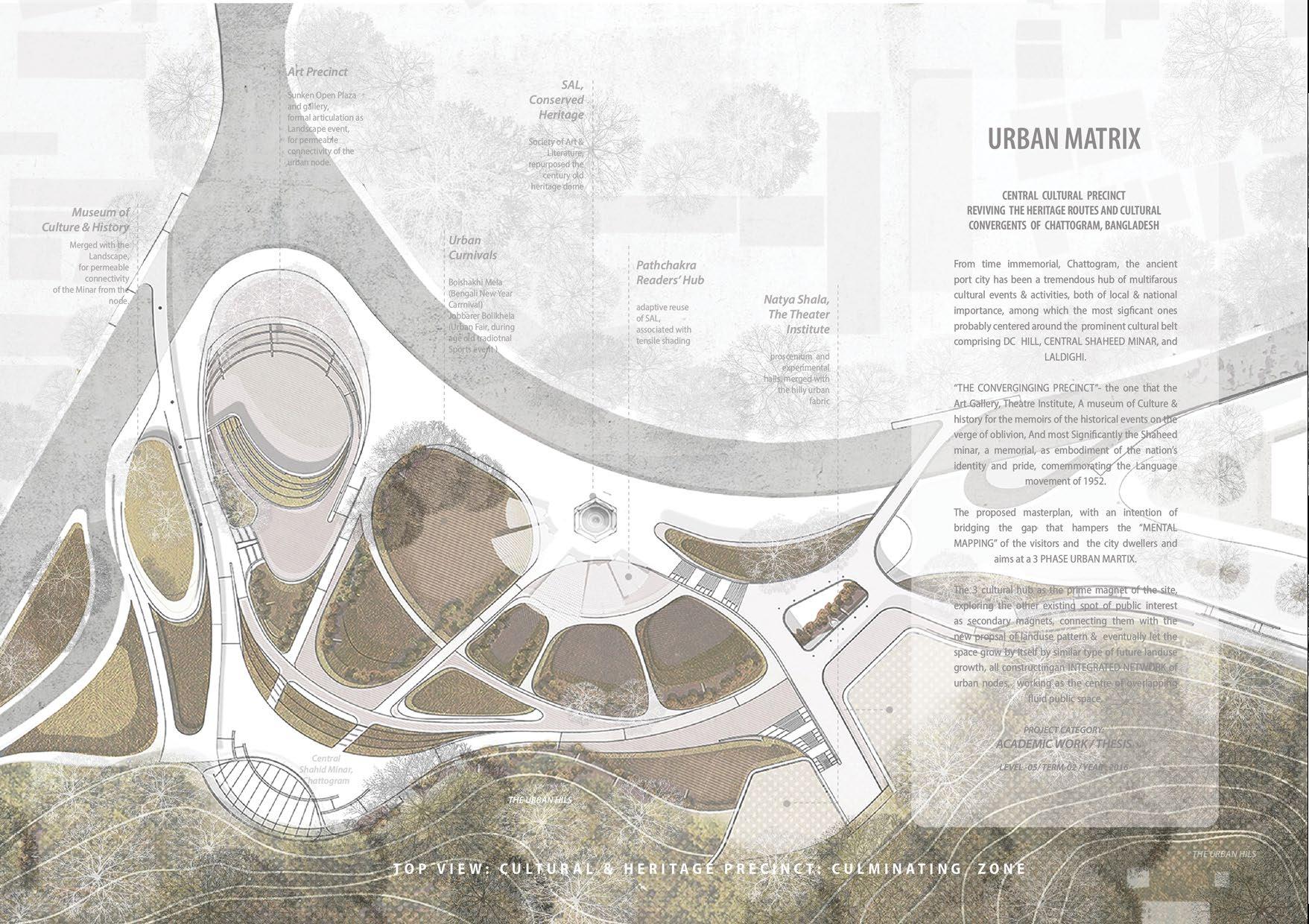
PROJECT CATEGORY: ACADEMIC WORK / THESIS
LEVEL -05/ TERM-02 / YEAR : 2016
TOP VIEW: CULTURAL & HERITAGE PRECINCT: CULMINATING ZONE
Central Shahid Minar, Chattogram
THE URBAN HILS THE URBAN HILS

SECTION THROUGH THE CULTURAL
PRECINT
Shahid minar precinct
Shahid minar precinct
Conserving the Urban Hills
Museum of Culture and History
Museum of Culture and History
The Theater Institute, Proscenium Hall
Carnival Field & Counter Assembly Flexible urban Space
The Art Plaza Sunken court for open exhibition and performance Book Shop and Readers’ Club
The Art Gallery Sunken exhibition space
SAL Society of Art & Literature
SAL : Society of Art & Literature
MEDIA HUB DISTRCIT COMMISSIONER’S OFFICE CITY CORPORATION OFFICE
A HISTORIC URBAN DEMOCRATIC SPACE
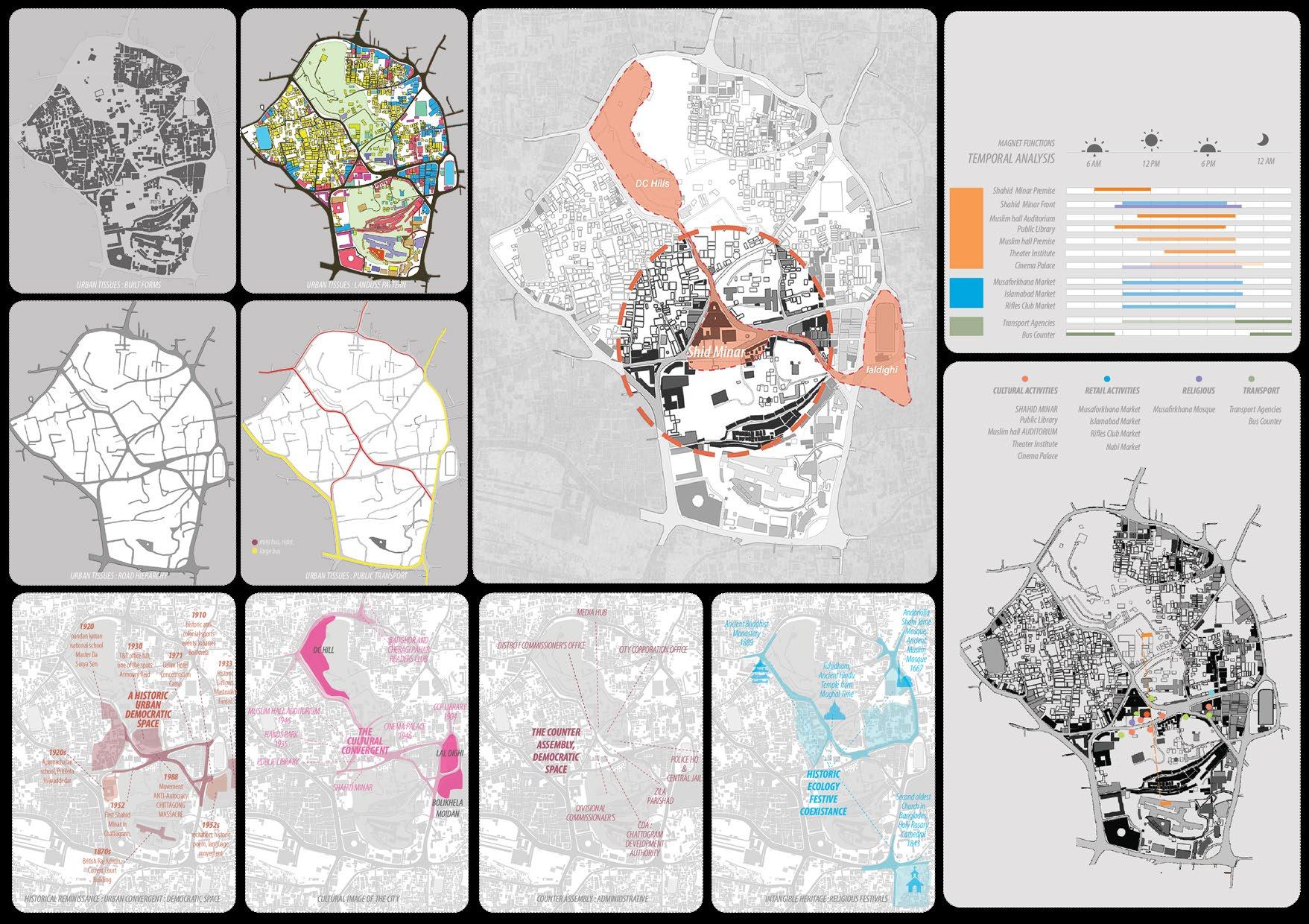
HALL AUDITORIUM 1946
CCP LIBRARY 1904
THE CULTURAL CONVERGENT
BOLIKHELA MOIDAN
THE COUNTER ASSEMBLY, DEMOCRATIC SPACE
DIVISIONAL COMMISSIONAER’S
POLICE HQ & CENTRAL JAIL
ZILA PARISHAD
CDA CHATTOGRAM DEVELOPMENT AUTHORITY
Ancient Buddhist Monastery
Tulsidham, Ancient Hindu Temple from Mughal Time
HISTORIC ECOLOGY FESTIVE COEXISTANCE
Musaforkhana Market Musaforkhana Market Musafirkhana Mosque
SHAHID
Andarkilla Shahi Jame Mosque, Ancient Muslim Mosque 1667
Second oldest Church in Banglades, Holy Rosary Cathedral 1843
Shid Minar HISTORICAL REMINISSANCE URBAN CONVERGENT DEMOCRATIC SPACE URBAN TISSUES ROAD HIERARCHY
TISSUES BUILT FORMS URBAN TISSUES PUBLIC TRANSPORT URBAN TISSUES : LANDUSE PATTERN CULTURAL IMAGE OF THE CITY COUNTER ASSEMBLY ADMINIDSTRATIVE INTANGIBLE HERITAGE :RELIGIOUS FESTIVALS MAGNET FUNCTIONS TEMPORAL ANALYSIS
AM
URBAN
6
Shahid Minar Premise Shahid Minar Front Muslim hall Auditorium
MINAR Public Library Public Library Muslim hall Premise Muslim hall AUDITORIUM
RETAIL ACTIVITIES RELIGIOUS TRANSPORT CULTURAL ACTIVITIES Transport Agencies
Palace Cinema Palace Rifles Club Market Rifles Club Market Nabi Market Bus Counter Bus Counter 12 PM 6 PM 12 AM mini bus, rider, large bus LAL DIGHI DC HILL PUBLIC LIBRARY SHAHID MINAR CINEMA PALACE 1946
READERS CLUB
Theater Institute Theater Institute Islamabad Market Islamabad Market Transport Agencies
Cinema
BATIGHOR AND CHERAGI PAHAR
1889
1920 nandan
Surya
Aparnacharan
1952 First Shahid Minar in
1870s British Raj Admin, Current Court Building 1952s recitation:
poem, language movement 1930 T&T office
one of the spots
1971 Dalim
Concentration Camp 1988 Movement
1933 Historic Gallows Masterda’s Fanshi 1910 historic
kanan national school Master Da
Sen 1920s
school, Pritilota Wayaddedar
Chattogram,
historic
hill,
Armoury Reid
Hotel
ANTI-Autocracy CHITTAGONG MASSACRE
anti colonial sports events Jobarrer Bolikhela
MUSLIM
HANDS PARK 1935
February 21
Shahid Disbosh - Provat feri Procession comemmorating International Mother Language Day, the Language Movement and martyrs of 1952, Shahid Minar

March 26
Shadhinota Disbosh
The Independance Day Procession comemmorating Declaration of Independance in 1971, Shahid Minar Precinct
Bijoy Disbosh
July
February 13
June
December 16
The Victory Day Comemmorating the victory after nine months of liberation war1971, Shahid Minar Precinct
April 24
January 13
Pohela Falgun
First Day of Spring in the Bengali Calender , DC Hill Precinct
Poush Shongkranti
Traditional Food and Cake festival Day of the Bengali month “Poush”, DC Hill Precinct
Jobbarer Boli Khela
Traditional open wrestling tournament, starting in 1907, symbolizing the fight against colonization. in the first month of bengali new year, typically April 20-25 at the historical Lal Dighi field.
Boli Khelar Mela
February 1-28
Boi Mela
Month long Book Fair celebrating the language movement of 1952, DC Hill & Shahid Minar
TEMPORAL DIMENSION AND FLUID URBANISM, INTANGIBLE HERITAGES IN THE VIBRANT URBAN CALENDAR
April 1-30
Traditional Street Fare of Tradtional potteries Laldighi to Shahid Minar Streets
Nobobarsha - Mangal
Shova Jatra
April 14
Bengali New Year Celebration, Procession with traditional maskots DC Hill
DERIVING THE URBAN MATRIX
INTER CONNECTIVITY
Among Cultural Landmarks: Public Library, Muslim Hall Auditorium & Theater Institute
DC HILL PRECINCT
BUILT HERITAGE OLD BUDDHIST TEMPLE
LAND USE CODE : CRAFTS SHOPS, ART CAFE AND SIMILAR
INTER -NODAL CONNECTIVITY
With Shaheed Minar as the Image of Cultural and National Identity
ADAPTIVE REUSE: COLONIAL PERIOD BUILDING INTO LIBRARY AND CURIO SHOPS
TULSI DHAM OLD HINDU TEMPLE
SPOT OF INDIAN ANTICOLONIAL MOVEMENT
INTER -HILLS AND INTRA PLAZA CONNECTIVITY With Cultural landmarks and Conserved Hills and Heritages Functional
LANDUSE, LEGIBILITY : RELOCATION & ADAPTIVE REUSE
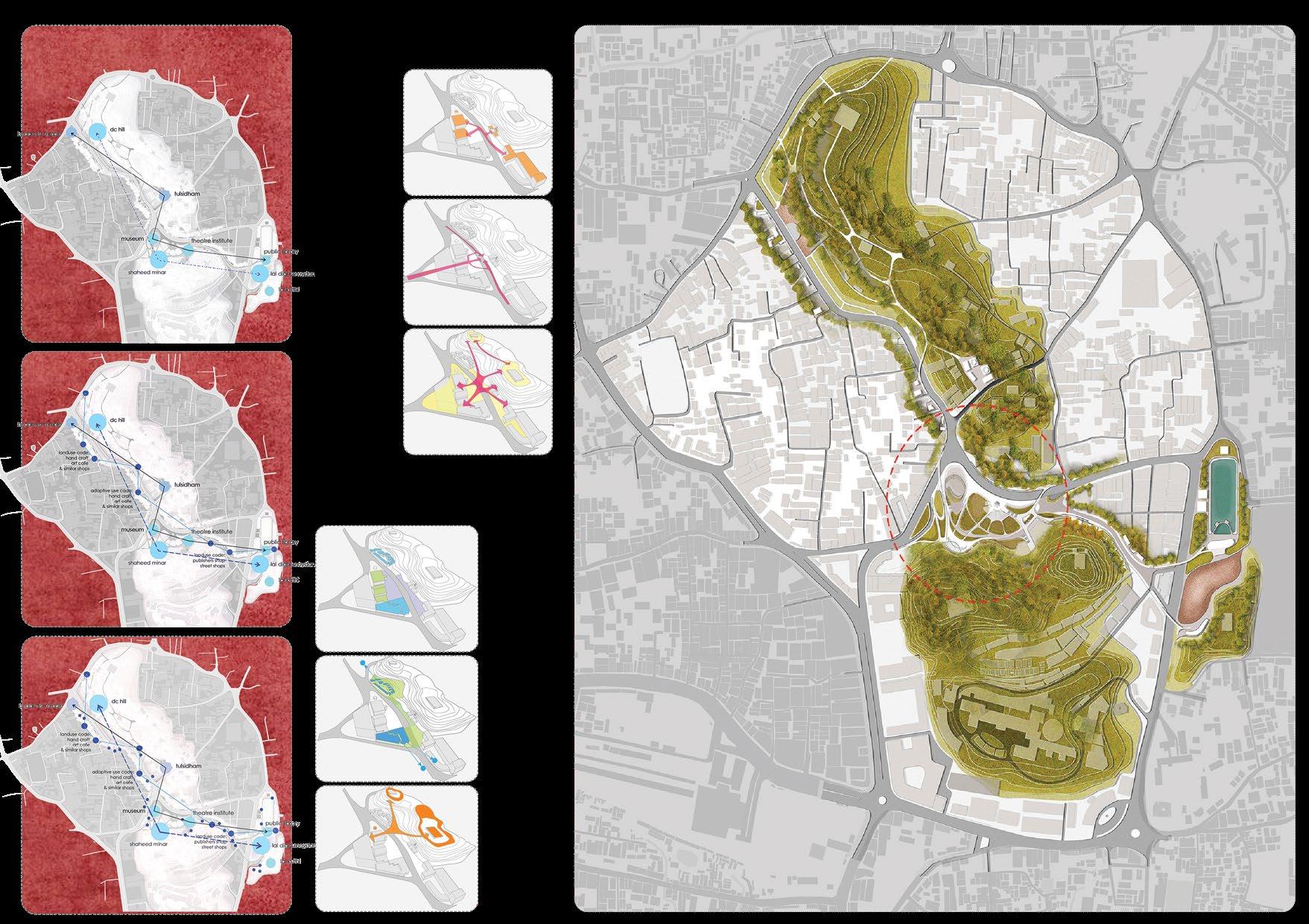
SHAHID MINAR ART PLAZA, MUSEUM OF HISTORY, SAL, THEATER INSTITUTE
CENTRAL CULTURAL PRECINCT CONVERGENT OF CULTURAL
URBAN HILLS WASA PAHAR,COLONIAL PERIOD WATER RESERVOIR, CONVERTED INTO PUBIC VIEW PLAZA
URBAN HILLS & HERITAGE COLONIAL PERIOD HEITAGE BUILDING, CONVERTED INTO PUBLIC ENTERTAINMENT & PERFORMANCE ZONE
URBAN HILLS & HERITAGE: PORIR PAHAR,COURT BUILDING, COLONIAL PERIOD ADMININSTRATIVE BUILDING, NOW CENTRAL COURT OF CHATTOGRAM
LAL DIGHI
RESTORED LIBRARY
“Maidan” LAL DIGHI FIELD
BOLIKHELA Lal kuthiConserved Heritage from colonial period, preserved gallows in Chittagong Central Jail, where the great indian natioanlist Surya Sen was hanged
PHASE 03 PHASE 02 PHASE 01
SYMBIOSIS : THREE PHASE URBAN MATRIX THE URBAN MATRIX : REVIVING THE HERITAGE AND CULTURAL CONVER-
FLUID URBANISM
Alocation Commercial Relocation Cultural Allocation Fusion Functional
Alocation Commercial Relocation Cultural Allocation Fusion
Relocation&
Relocation&
cultural
cultural commercial
Adaptive repurpose Repurposing conserved built heritages.
commercial unplanned development
unplanned development
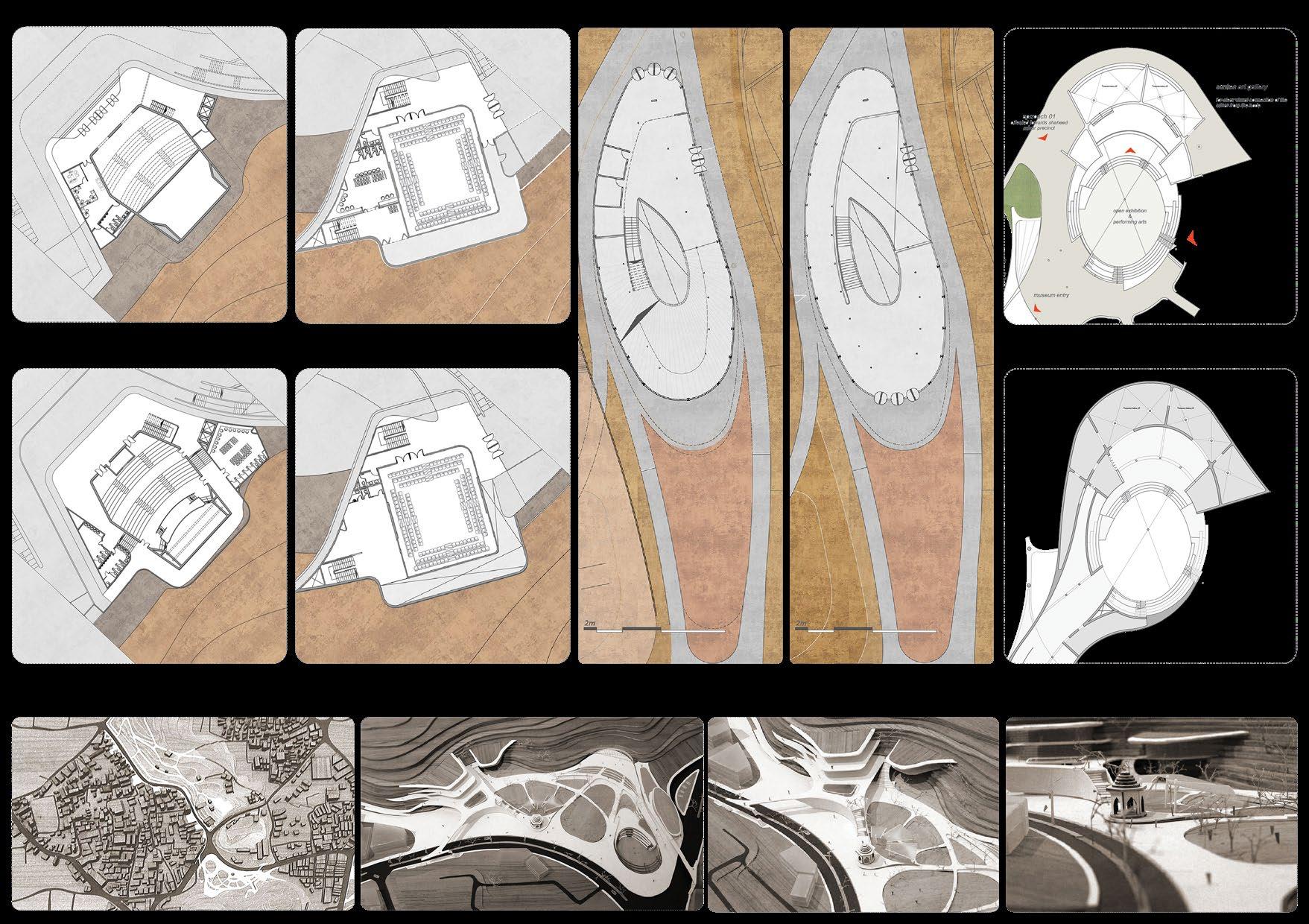



 THE PROSCENIUM THEATER LOWER LEVEL PLAN
THE PROSCENIUM THEATER UPPER LEVEL PLAN
THE EXPERIMENTAL HALL THEATER UPPER LEVEL PLAN
THE MUSEUM OF THE PAST : CHATTOGRAM LOWER LEVEL PLAN
THE MUSEUM OF THE PAST : CHATTOGRAM UPPER LEVEL PLAN
THE MUSEUM OF THE PAST CHATTOGRAM UPPER LEVEL PLAN
THE MUSEUM OF THE PAST CHATTOGRAM UPPER LEVEL PLAN
THE PROSCENIUM THEATER LOWER LEVEL PLAN
THE PROSCENIUM THEATER UPPER LEVEL PLAN
THE EXPERIMENTAL HALL THEATER UPPER LEVEL PLAN
THE MUSEUM OF THE PAST : CHATTOGRAM LOWER LEVEL PLAN
THE MUSEUM OF THE PAST : CHATTOGRAM UPPER LEVEL PLAN
THE MUSEUM OF THE PAST CHATTOGRAM UPPER LEVEL PLAN
THE MUSEUM OF THE PAST CHATTOGRAM UPPER LEVEL PLAN
CENTRAL CULTURAL PRECINCT MODEL THE THEATRES AND THE OLD STRUCTURE MODEL : ADAPTIVE REPURPOSING THE OLD STRUCTURE MODEL : SITE SURROUNDING AND THE URBAN MATRIX
THE EXPERIMENTAL HALL THEATER LOWER LEVEL PLAN
MODEL THE
MONGOL SHOVAJATRA PROVAT FERI COUNTER ASSEMBLY : DEMOCRATIC SPACE
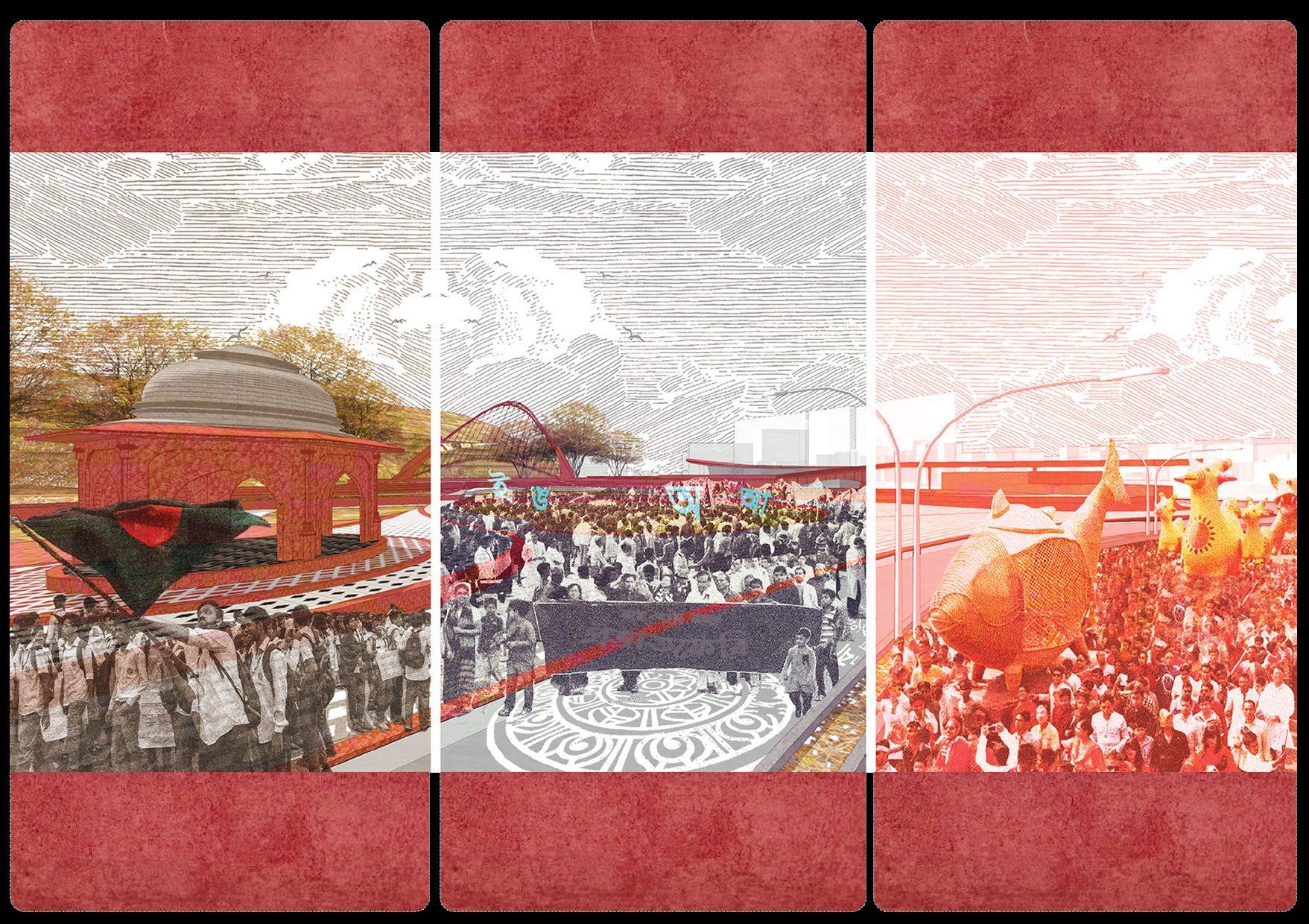 THE “PROVAT FERI” AGE OLD PROCESSION CELEBRATING 21ST FEBRUARY, NTERNATIONAL MOTHER LANGUAGE DAY
THE COUNTER ASSEMBLY A DEMOCRATIC SPACE FOR CENGRESSION, IN FRONT OF SHAHEED MINAR, THE NATIONAL ICON FOR MOVEMENT AGAINST AUTOCRACY AND DISCREAMINATION
THE “MONGOL SHOVAJATRA” HERITAGE PROCESSION CELEBRATING POHELA BOISHAKH, THE BENGALI NEW YEAR
THE “PROVAT FERI” AGE OLD PROCESSION CELEBRATING 21ST FEBRUARY, NTERNATIONAL MOTHER LANGUAGE DAY
THE COUNTER ASSEMBLY A DEMOCRATIC SPACE FOR CENGRESSION, IN FRONT OF SHAHEED MINAR, THE NATIONAL ICON FOR MOVEMENT AGAINST AUTOCRACY AND DISCREAMINATION
THE “MONGOL SHOVAJATRA” HERITAGE PROCESSION CELEBRATING POHELA BOISHAKH, THE BENGALI NEW YEAR
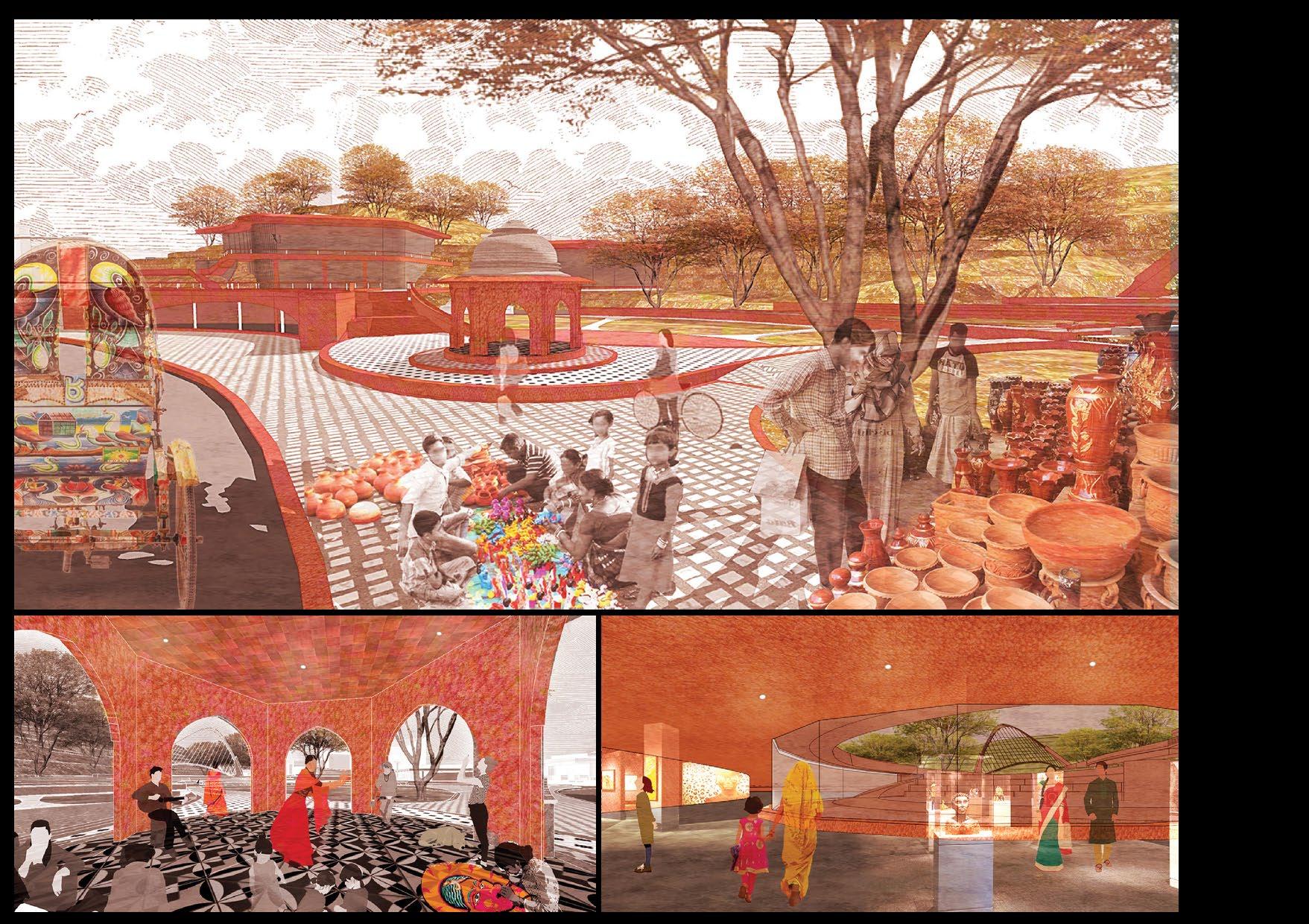
SCHOOLING IN THE HILLS
PRIMARY SCHOOL FOR THE CHAKMA COMMUNITY, GOLAICHORI VILLAGE, KAPTAI LAKE, RANGAMATI.
The project was initiated broadly as a real world exposure to the prevailing cultural and topographical context in Bangladesh, uniquely diversified depending on the geographical location, while the studio objective was designing learning spaces for the ethnic communities of the country. The allocated site, in this case, was on the remote bank of the hisroric Kaptai lake, which itself was a man made water body that formed during the hydroelectric project in 1960s. The lake uprooted the ethnic Chakma Communities, who were forced to migrate to the upper hill region due to the massive inundation. The design of the learning space deliberately opted for the unique culture and spatial wisdom of the Chakma community, form the choice of materials to the arrangement and scale of the class blocks.The settlement studies and behavioral observation led to the final outcome which preferred the inclusion of semioutddor spaces, connected to each of the classes, facing the lake and provide with scope of learning within the own spatial ambience.
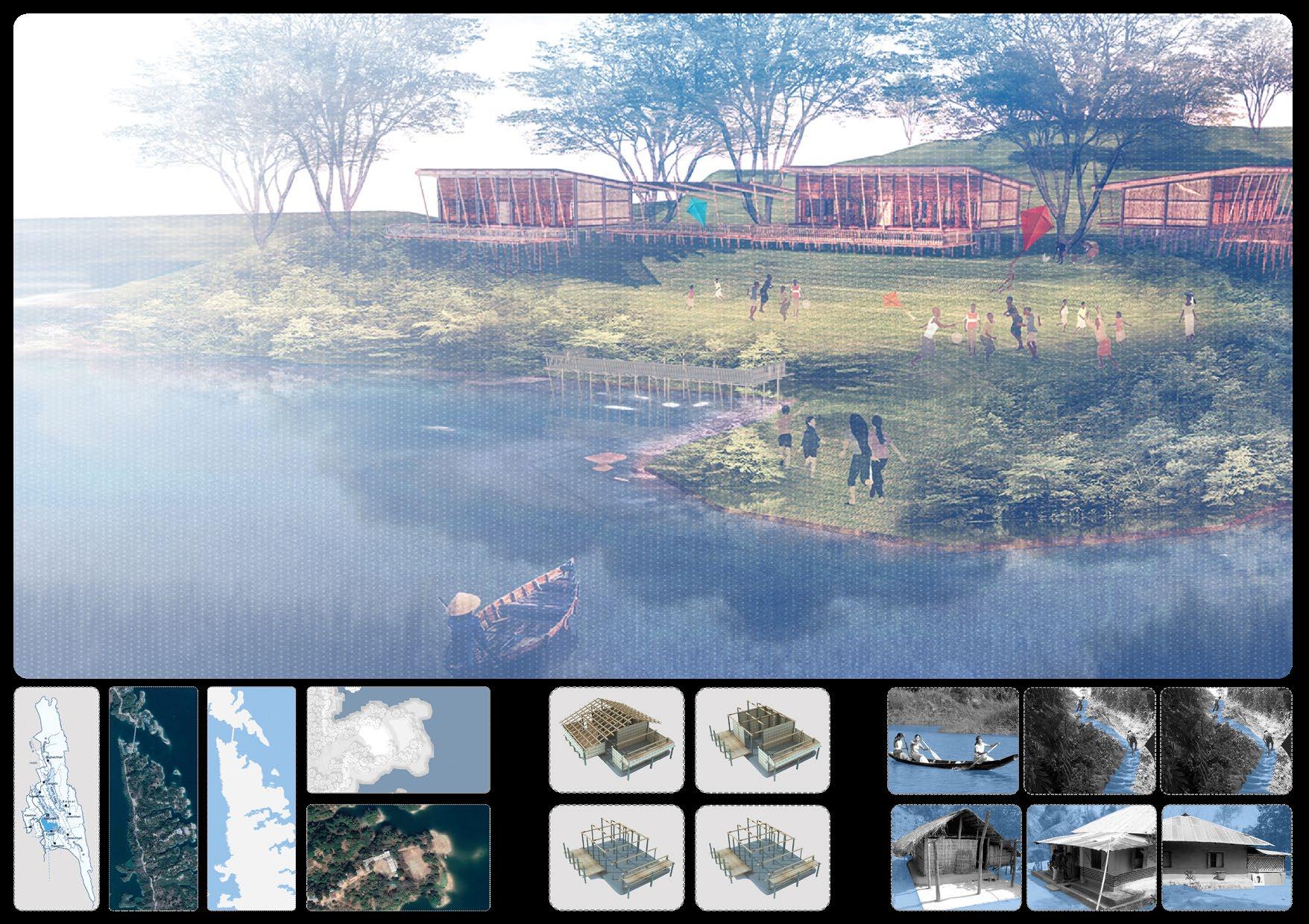
PROJECT CATEGORY: ACADEMIC WORK
LEVEL -03/ TERM-01 / YEAR : 2014
BUILT FORM PATTERN APPROACHES TO SITE LOCAL CONSTRUCTION METHOD ANALYSIS
PANI MACHANG
LAKE SIDE PAVILION FOR LEISURE AND REST
SERVICE FACILITY
SERVICE FACILITY
SHRENI KAKSHA & SHIKSHA MACHANG
CLASSROOMS - MORPHOLOGY, SPATIAL QUALITY AND MATERIALS, DELIBEARATELY SIMILAR TO CULTURAL IDENTITY,
INTEGRATED WITH LAKE FACED BAMBOO MACHANG AS OOPEN CLASSROOM
BAGAN & BIGYAN GHOR SCIENCE LAB WITH A SMALL VEGETABLE GARDEN IN FRONT TO BE MAINTAINED BY KIDS
THE GHAT BOAT STATION FOR THE STUDENTS COMING FROM OTHER SIDES OF THE LAKE
PATHAGAR CHAKMA LANGUAGE CLUB
LIBRARY WITH OUDOOR AND INDDOOR SEATING AND READING FACILITY
KRIRA-GHOR
INDOOR GAMES FACILITY AND PAVILION / SHED AS GALLERY SPACE
PANI MACHANG
LAKE SIDE PAVILION FOR LEISURE AND REST
MASTER PLAN : PROPOSED GOLAICHORI SCHOOL
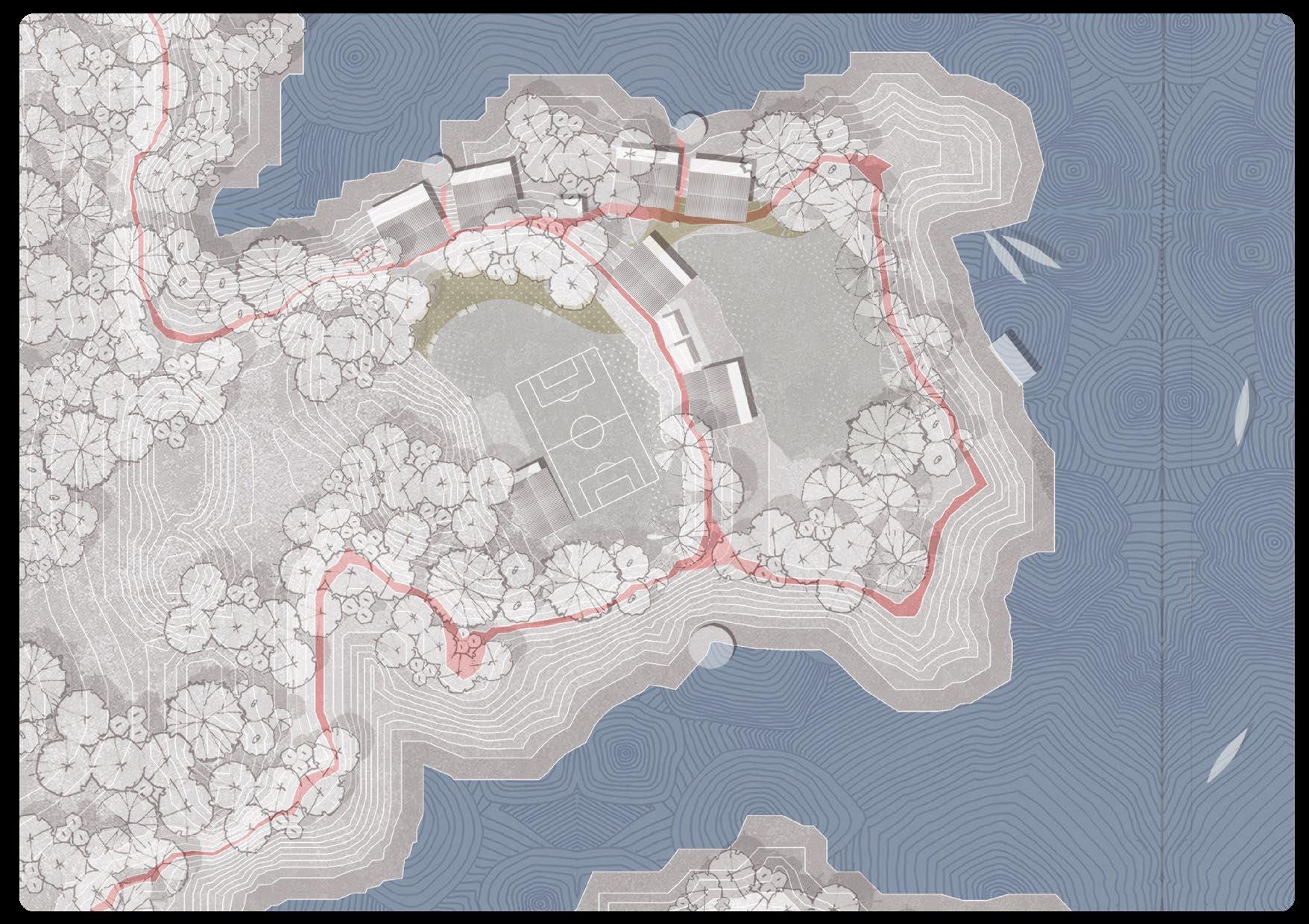
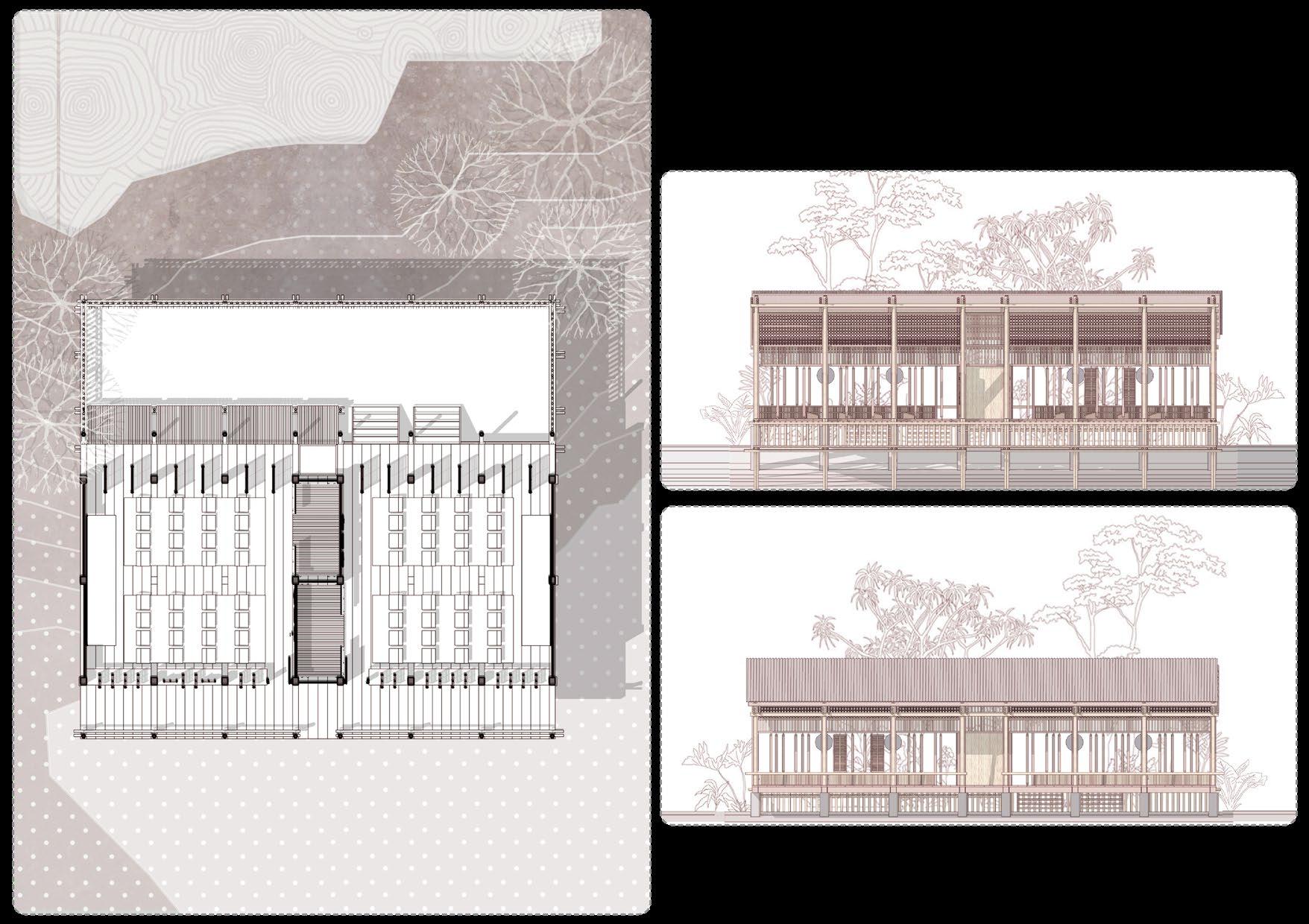
side elevation
Field side elevation PLAN : INDOOR OUTDOOR INGRATED CLASSROOM INNER FIELD SIDE BAMBOO MACHANG OUTDOOR CLASS INDOOR CLASS 01 STORAGE ENTRY CORRIDOR, SERVING AS SHADED GALLERY FOR THE FIELD INDOOR CLASS 02 INDOOR CLASS 01 INDOOR CLASS 02 KAPTAI
Lake
Inner
LAKE
VERNACULAR ROOF
TRADITIONAL MATERIALS, NORTH LIGHT INTAKE
THE INNER COURTS
INDOOR OUTDOOR CONNECTIVITY, SHADED GALLERY FOR THE PLAY FIELD
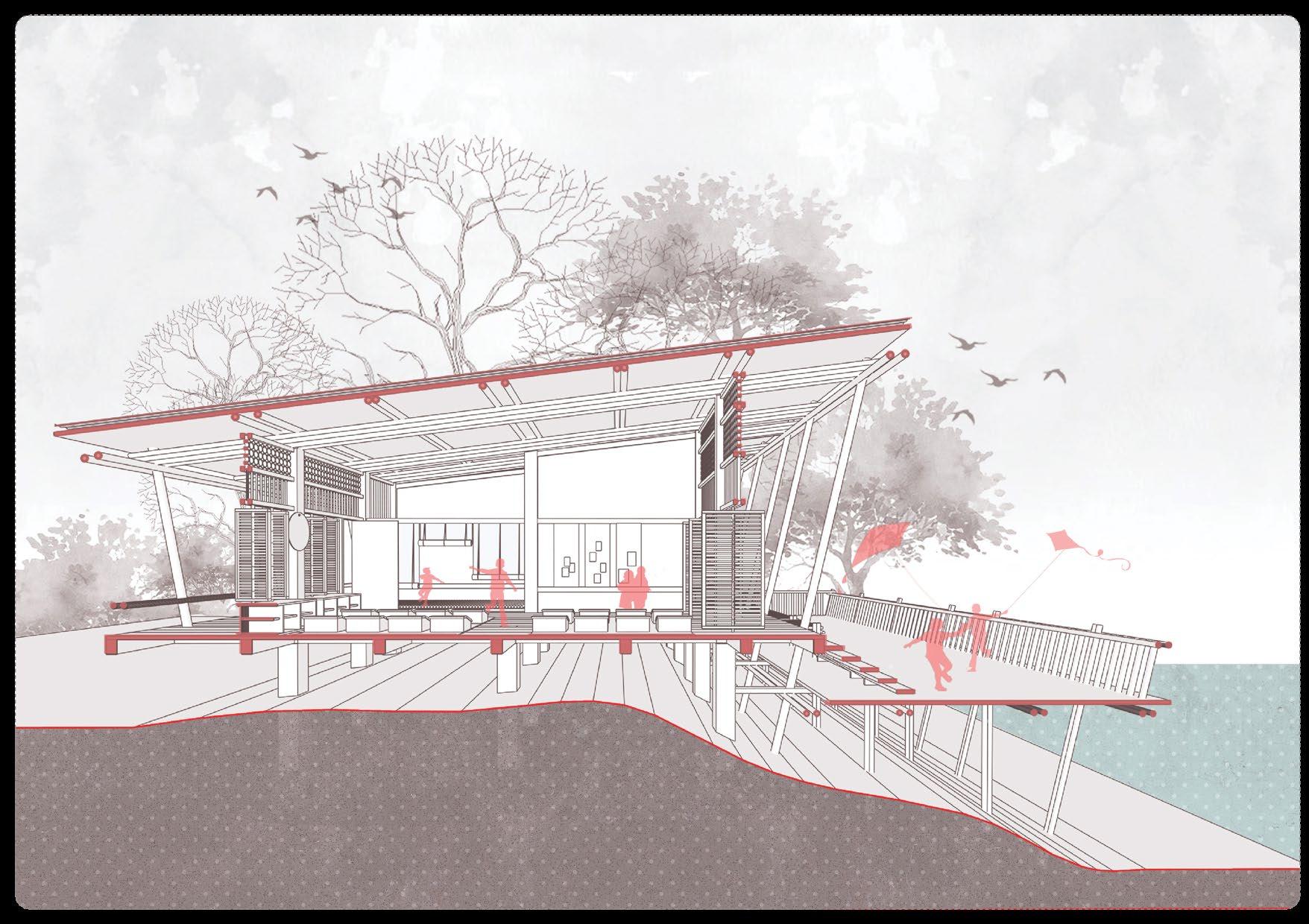
INDOOR CLASSROOM
FLEXIBLE OPEN FORMAT, WELL LIT, VENTILATED, TWO FOLD CONNECTION TO OUTDOOR
OUTDOOR CLASS ROOM
TRADITIONAL SPATIAL MORPHOLOGY, ALIGNED WITH BEHAVIORAL STUDY
SENTITIVELY GROUNDED
VERNACULAR METHOD OF PLACING THE BUILT MASS UPLIFTED TO LEESN THE IMPACT ON HILLY TOPOGRAPHY
SECTION THROUGH THE CLASSROOM : INDDOR OUDOOR CONNECTIVITY
MOVABLE CLASSROOM PARTITION
Made of Bamboo, for resisting, materiality, cuktural resemblence
BAMBOO RAFTER & LASHING
Made of Bamboo, for resisting, materiality, cuktural resemblence
PRECAST RCC FOOTING :
Made of Bamboo, for resisting, materiality, cuktural resemblence
BAMBOO COLUMN :
Made of Bamboo, for resisting, materiality, cuktural resemblence
WOODEN FLOORING DETAILS :
Made of Bamboo, for resisting, materiality, cuktural resemblence
RAILING DETAILS :
Made of Bamboo, for resisting, materiality, cuktural resemblence
ROOFLING LAYER 01
PERFORATED BAMBOO SCREENING
Made of Bamboo, for resisting, materiality, cuktural resemblence
ROOFLING LAYER 02
PIVOTAL WINDOW
STRUCTURAL PORTION : BAMBOO BEAM, STRENGTHENED BY TIEING 4 BAMBOOS, RIBBED FRAME PATTERN
Wooden Frame bamboo infill. Pivots around a thinner bamboo post
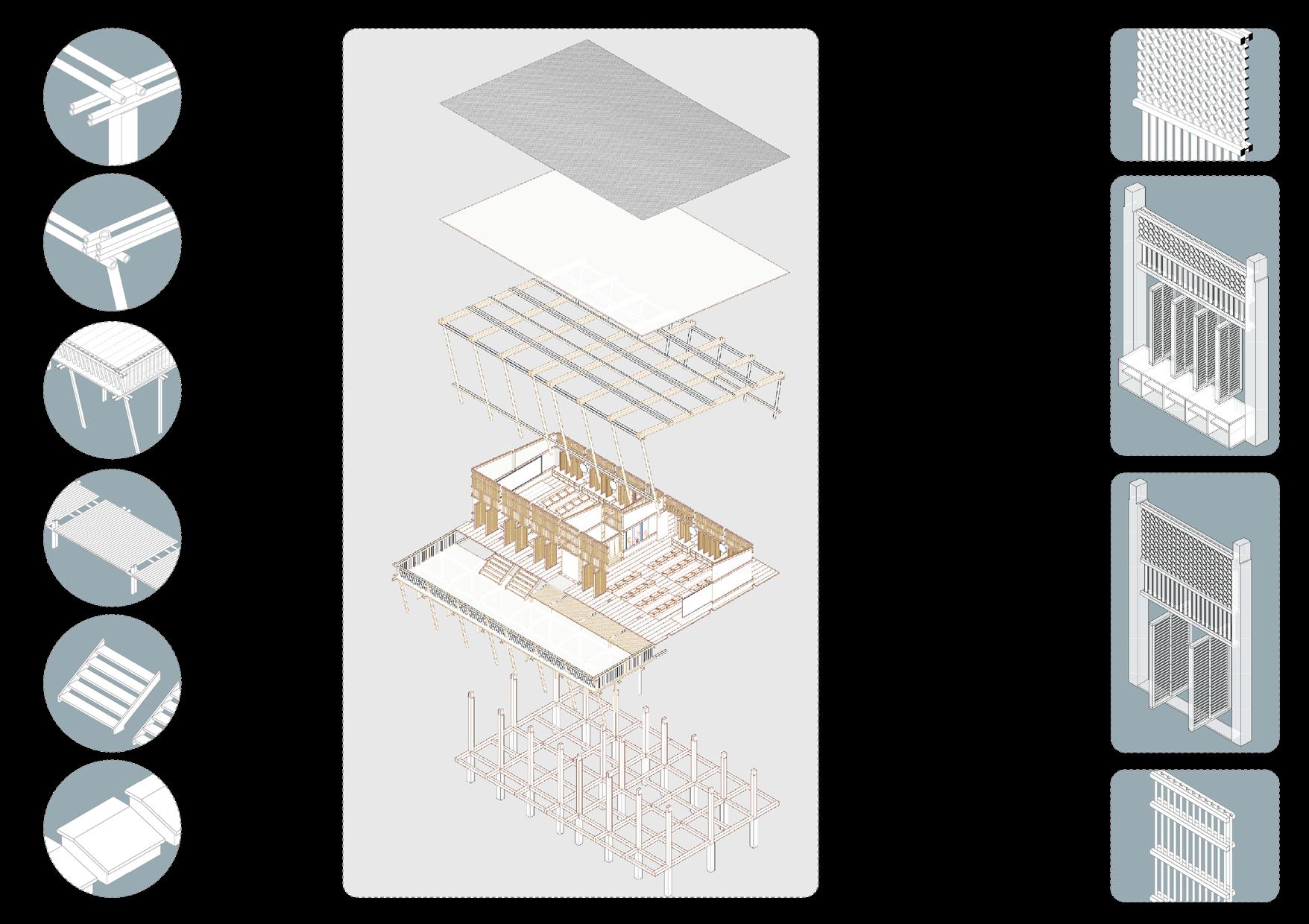
BUILT IN WINDOW LOCKER:
Made of Bamboo, for resisting, materiality, cuktural resemblence
OUTER INCLINED BAMBOO COLLUMNS
BAMBOO SCREENING AND WOODEN DOORS AND WINDOWS, AS WALL FILLER
WOODEN PLANK FLOOR
OUTDOOR CLASSROOM AS BAMBOO TERRACE OR MACHANG
TRADITIONAL / PORTABLE BENCHES:
WOODEN COLLUMNS AS PRIMARY STRUCTURE
Made of Bamboo, for resisting, materiality, cuktural resemblence
WOODEN BEAMS BENEATH THE USUABLE FLOORS RESTING ON MODULAR PRECAST RCC FOOTING
STAIR DETAILS:
Made of Bamboo, for resisting, materiality, cuktural resemblence
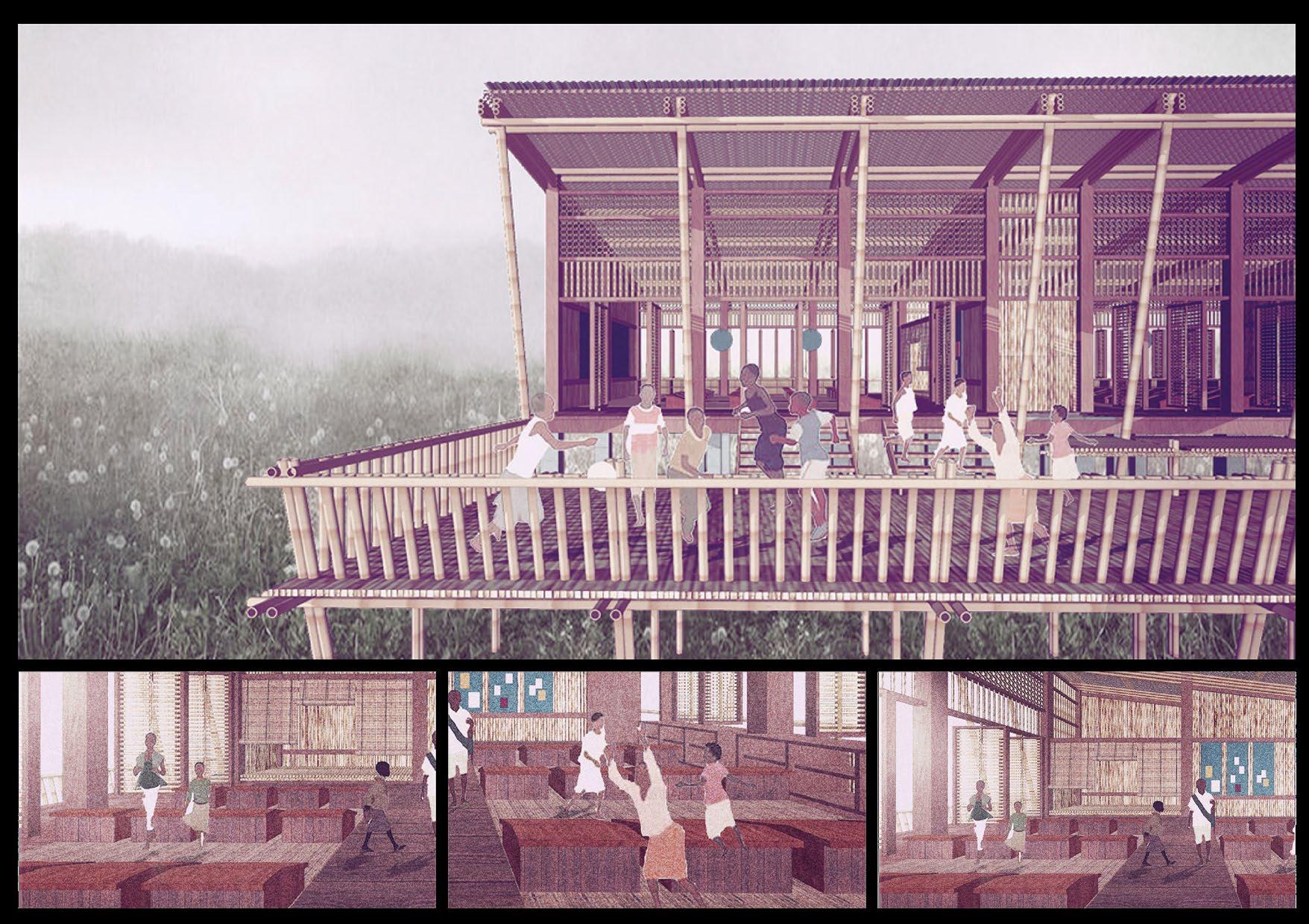
“JON-JOMI-JOL”
COMPACT TOWNSHIP: MAJHI PARA, AN OLD FISHERMEN VILLAGE
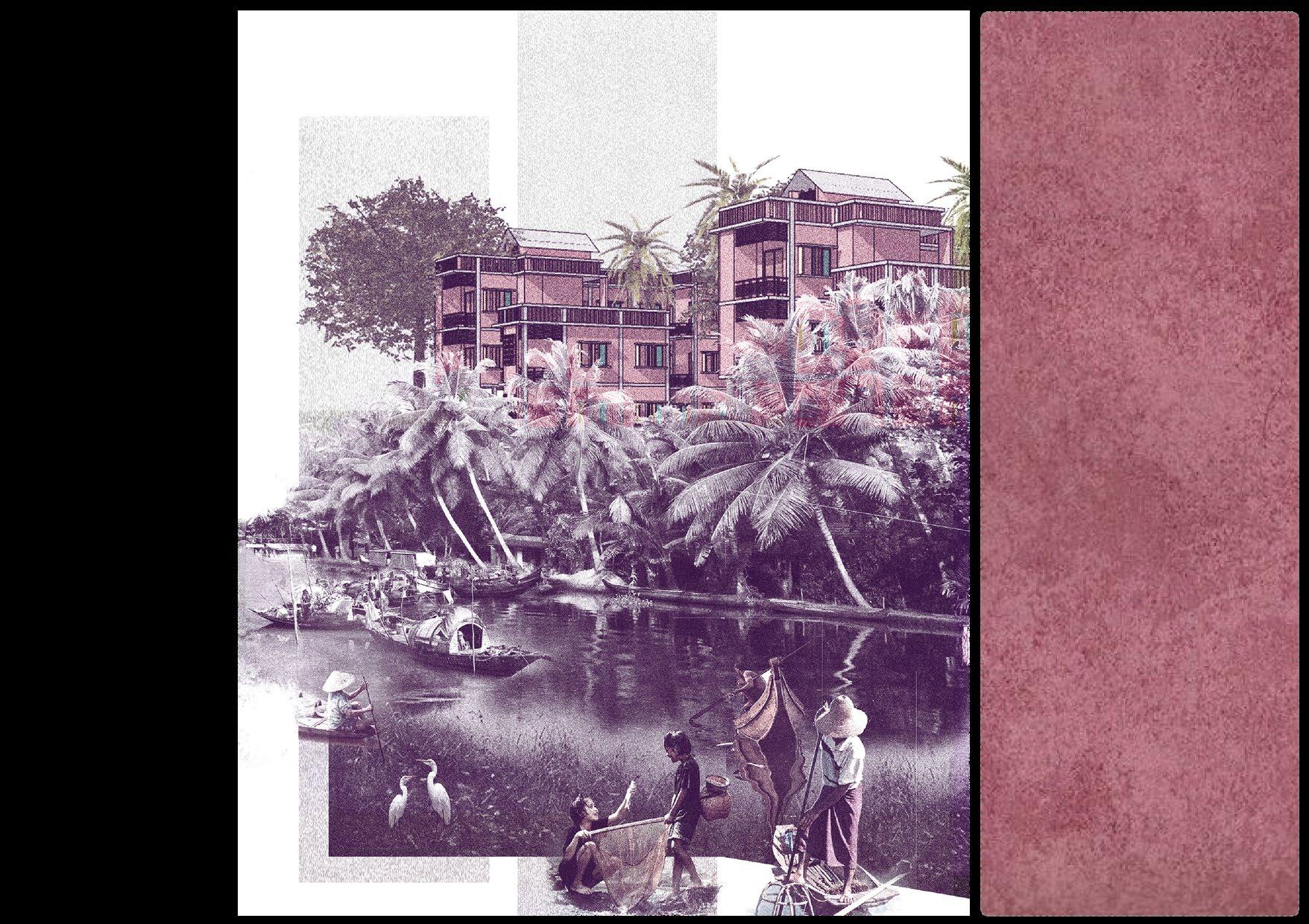
Majhipara, Boroibari Village, Gazipur, bangladesh
From time immemorial, Chattogram, the ancient port city has been a tremendous hub of multifarous cultural events & activities, both of local & national importance, among which the most sigficant ones probably centered around the prominent cultural belt comprising DC HILL, CENTRAL SHAHEED MINAR, and LALDIGHI.
“THE CONVERGINGING PRECINCT”- the one that the Art Gallery, Theatre Institute, A museum of Culture & history for the memoirs of the historical events on the verge of oblivion, And most Significantly the Shaheed minar, a memorial, as embodiment of the nation’s identity and pride, comemmorating the Language movement of 1952.
The proposed masterplan, with an intention of bridging the gap that hampers the “MENTAL MAPPING” of the visitors and the city dwellers and aims at a 3 PHASE URBAN MARTIX.
The 3 cultural hub as the prime magnet of the site, exploring the other existing spot of public interest as secondary magnets, connecting them with the new propsal of landuse pattern & eventually let the space grow by itself by similar type of future landuse growth, all constructingan INTEGRATED NETWORK of urban nodes, working as the centre of overlapping fluid public space.
PROJECT CATEGORY: ACADEMIC WORK
LEVEL -04/ TERM-02 / YEAR : 2015
Majhi Para Settlement (Extended)

1971: Mass Migration
The communal aggression was at its worst during the liberation war, Many homesteads were seized, which caused a further decrease in their land occupation and a massive migration of Hindu fishermen.
Majhi Para Settlement (Decreasing)
1974 : Construction of Road
The link road seriously hampered the flow of the ‘Choto Khal”, a rivulet passed by the Majhipara. The fishermen were mainly dependent an “Choto Khal’ for fishing, but with the construction of the road, the rivulet began to die out.
Majhi Para Settlement
Road connectecting the sides of chotokhal
Majhipara : Current Settlement
Majhipara Old Settlement Chotokhal
The canal
The Road that obstructed Chotokhal’s Flow
The River Turag
The Bridge that obstructed Turag’s flow & led to dying of the Chotokhal
number of families 72 - 80 main religion Hinduism (about 70 hindu families & 3 muslim families)
profession: seasonal fishermen: ( 2-3 seasons of monsoon) during off season fishing retailer, tempo-driver, rickshaw puller, daily laborer.
ownership of land: owns the “Vita”(habitat land) no ownership of agricultural land
1980s: Industrial Pollution
The increasing number of industries on the bank of the Turag posed a great threat to the neighboring environment, the fishermen being the worst ones of the victims. The industrial pollutants directly affected the number of fish resources, eventually the river based community became on the verge of extinction.
The new roads initiated lots of unplanned development and environmental pollution risking the river halth severely.
Tin Shed semi pacca, and pacca houses, change in building materials, unplanned development
1988 : Grameen Bank
The community were introduced to micro credit system in 1988 with the establishment of the Grameen bank. with all its other contribution at socio economic area, it triggers a vast change in the homestead, as many fishermen families, with the help of Grameen bank’ easy credit system, were able to construct houses with tin, a material new to the community.
2002: Construction of Bridge
The dying of the “ Choto khal” was almost ensured when the a bridge was constructed in over it. Now it remains as a tiny water flow, almost invisible when it’s not the monsoon.
Bridge over the Turag, led to ultimate dying of the chotkhal, the fishing profession on the verge of extinction
MAJHII PARA : STORY OF CHANGE OVER TIME
1963 1971 1974 1980 1985 1988 2000 2022 2003 2013 1963 1971 1974 1980 1985 1988 2000 2022 2003 2013 1963 1971 1974 1980 1985 1988 2000 2022 2003 2013 1963 1971 1974 1980 1985 1988 2000 2022 2003 2013 1963 1971 1974 1980 1985 1988 2000 2022 2003 2013 1963 1971 1974 1980 1985 1988 2000 2022 2003 2013
The Canal (Chotokhal) Shalban (The Shal Tree Forrest)
NON FISHING HUB
The present trade of adopting non fishing based professions. The proposed hub will incorporate communal facilities like health facilities, relocation of school, vocational training center & other public facilities. The hub was proposed as the center of communal & public activities, to facilitate their flexibility of adopting professions other than fishing.
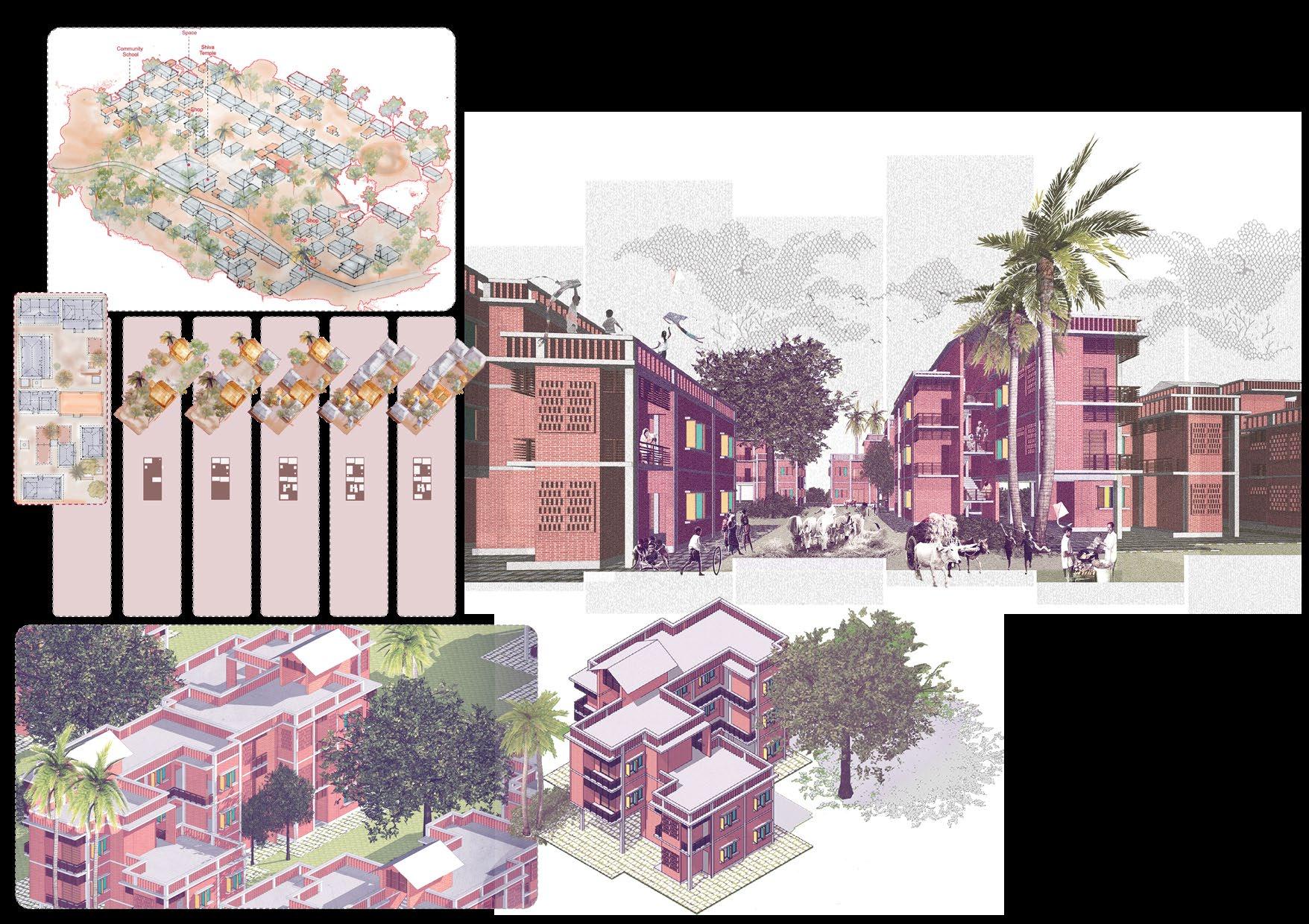
FISHING HUB
Analysis of the present trend of adopting nonfishing professions reveals mainly “Passive reasons” working behind it, the proposed hub will incorporate facilities like Communal Center for fishing business with temporary sheds for local fish market, Cold Storage & other facilities to link the fishing community with broader markets as influential fish suppliers.

SETTLEMENT PATTERN GENERATION 01 TRADITIONAL CLUSTER SAMPLE SETTLEMENT PATTERN GENERATION 02 SETTLEMENT PATTERN GENERATION 02 EXTENDED SETTLEMENT PATTERN GENERATION 03 SETTLEMENT PATTERN GENERATION 03 EXTENDED SETTLEMENT PATTERN Traditional
INTERNAL COURTYARD Continuation : Legacy Explore : New Professional INTER-COURTYARD connectivity LOW COST TRADITIONAL SWING WINDOW
organic fabrique
The Uplifted Ground Roof to roof connectivity
CLUSTER FORMATION : THE FLUID HIERARCHY OF OPEN SPACES
Analysis of the present trend of settlement pattern reveals mainly “courtyard to courtyard informal connection” working behind it, the communal connection in between the yards is, in fact the most vibrant part of the tradition living pattern, these are the bridges of the pseudoseparated individuals, the families with their neighbors, the community with their surrounding.

HIGH INCOME CLUSTER TYPE 01 : TYPICAL TYPE 02 TYPICAL TYPE 03 : TYPICAL TYPE 01 : GROUND TYPE 02 : GROUND TYPE 03 : GROUND MIDDLE & LOW INCOME CLUSTER RENTABLE CLUSTER 1. Higher income dwelling 2. Middle & Low income dwelling 3. Rentable dwelling 4. FIshing Hub 5. School 6. Conserved Shal Forrest 7. Seasonal Lifestyle Resort 8. Public Amenities 9. Commercial belt 6 7 1 2 3 5 8 8 9 6 4 MAJHII PARA PROJECTED SETTLEMENT PATTERN UNIT FORMATION CLUSTER FORMATION
HYDROPOD
INTEGRATED WATER HARVESTING AND PLAYSCAPE FACILITIES
The “Hydro Pod: A Water Harvesting Playscape” project is housed in the “Megher Bari” orphanage, which is located in Sonaichori Village, Naikhongchari Upazila, Bandarban. The Chittagong Hill Tracts’ indigenous children are provided with adequate care, education, and training at the orphanage, which is run by the nonprofit “Bidyanondo Foundation.”
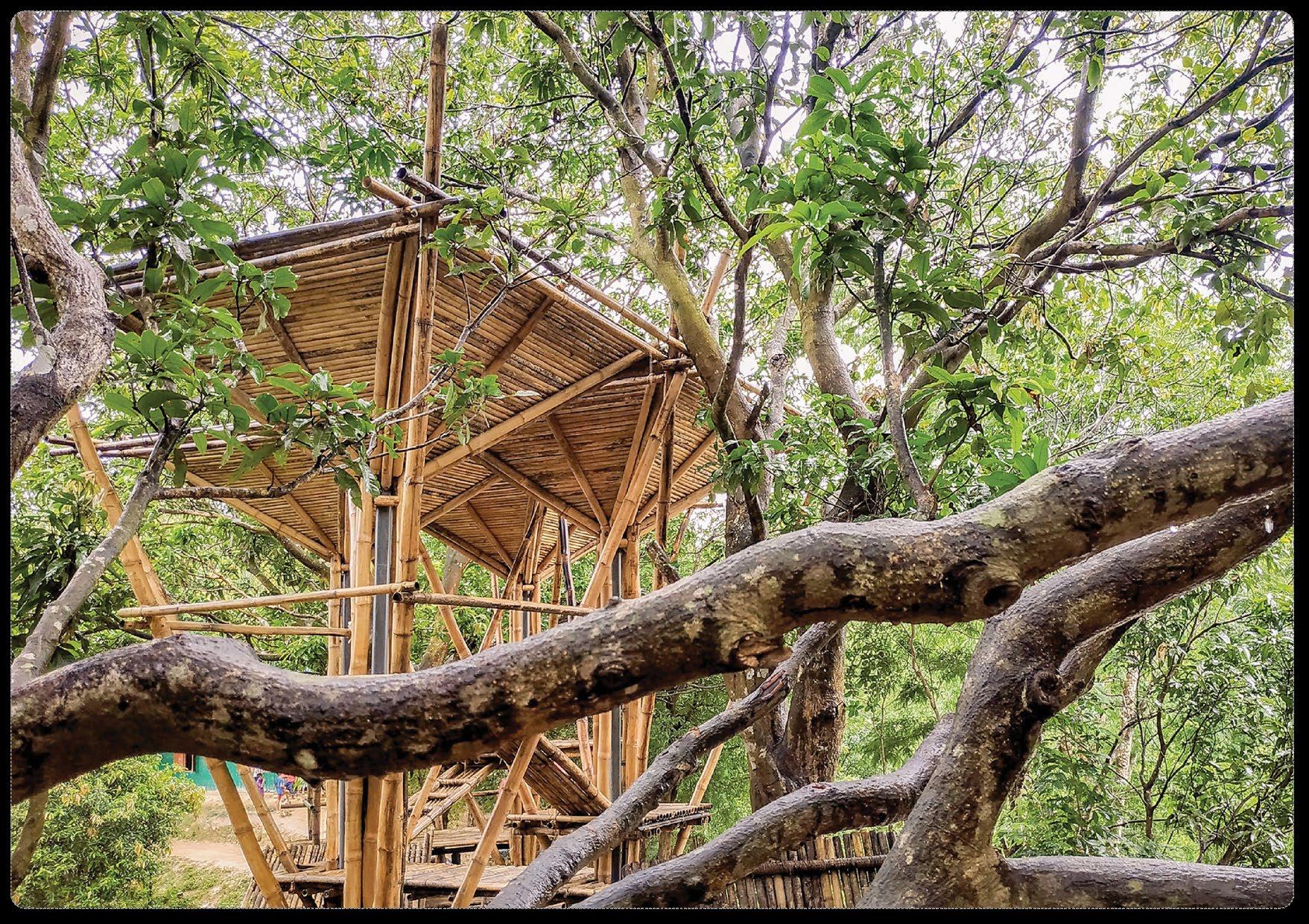
The chosen location, which is on a hill’s ridge, is devoid of proper electrical and communication infrastructure. The absence of clean drinking water at the location was one of the biggest problems. Usually, the closest stream was used to collect water. However, as the stream’s water level drops in the late summer and early winter, the situation worsens. The project was designed as a sizable water storage facility that can store rainwater for the duration of the dry season, along with rain catchers for rainwater collection during the wet season. Additionally, it provides a play area for the native kids at the orphanage on top of the reservoir. By purposefully avoiding the top-down method, the creation, collaboration, and making process of a local infrastructure ultimately resulted in an intervention that was warmly welcomed by the neighborhood and the children. This was likely due to the intervention’s unique formation, which included the use of local resources and techniques that reinforced the community’s cultural identity.
Status Built 2019-2020
Architectural Firm : Chorcha Sthapatijog
Team Work
Contribution to Team: Design Team Lead Design Decisions, Construction Documents Preparation, Workshop co-ordinator, Site Supervision
WATER CRISIS AND THE STEEP TRAIL
Everyday the little kids at the orphanage used to go through this steep hilly trail, an extremly risky one, to the downhill stream to collect water. The path being slopy, posed great danger of fatal accidents, only for the cause of water crisis.
STREAMS BECAMING DRIED UP AS WELL
Due to natural degradation caused by stone collection, and planting non native trees that affect the underground water level, the stream is slowly dying as well, leading to opting for an all out solution to solve the intimidating future.
A VULNARABLE DITCH & EROSIVE HILLTOP
In the first attempt, the local in charge of the orphanage wanted to construct an underground water reservoir tank to reserve stream water for the dry season. They selected the highest pick of the ridge so the water distribution could be done by the gravitational force. Howerver, without support from a professional, they cut the edge of the hill slope in a way that caused a vulnerable ditch. To prevent the land erosion they needed a very unique design solution.
 EXISTING FEMALE DORMITORY
HILLY TRAIL CONNECTING THE BUILT MASSES
THE LOCATION FOR THE INTERVENTION
EXISTING BOYS DORM
EXISTING FEMALE DORMITORY
HILLY TRAIL CONNECTING THE BUILT MASSES
THE LOCATION FOR THE INTERVENTION
EXISTING BOYS DORM
SPATIAL BEHAVIORAL OBSERVATIONS
To trace back the Cultural linkage with their perception and formation of spaces, empirical methods had been adopted. The study of surrounding households eventually resulted into observations about the spatial organisation, pattern of the community. It was observed that the site lacked flat land and the children were using some existing bamboo platform (Machang) for their daily activity and play. Findings of the indigenous construction traditions were infused with non-native materials and methods
WORKSHOP WITH THE KIDS & MENTAL MAPPING

A Day long interactive workshop was conducted which was participated by the resident children of the Child home ,for the purpose of mind mapping of the primary user group of the design and speculating an overview of how they perceive and interprete the idea of mono & multifunctional space. Followed by a lively ice breaking session , 87 students, grouped according to ages, were given interactive tasks of drawing their favourite spaces.
Then there was an one to one discussion session, while the kids described, in their own words, what they expect if they had the scope to design their favourite spaces. As the children were from diffrent language culture, local translator has an active participation in the process. The whole workshop session was documented and later shared with the client of the project.
MODEL
AS AN UNIVERSAL LANGUAGE TO COMMUNICATE & GETTING FEEDBACK FROM THE ARTISANS
The design process intentionally adopted the policy of avoiding the typical top-down method of design, transforming it rather into a participatory one. It acknowledged the prevailing “Design by Making” practice of the Local Marma community. There were some long informal Knowledge Sharing Sessions with the Marma artisans and craftsmen of the community. To overcome the linguistic limitation, the session included preliminary model making to express and combine the extract of the shared knowledge with the technicalities and design decisions.
The existing Ditch (size 19’x12’x varing height) of the site with sloping edge. This unplanned intervention by the local incharge caused soil erosion and needed a site specific solution.
Local Built Form, Technique & Resources
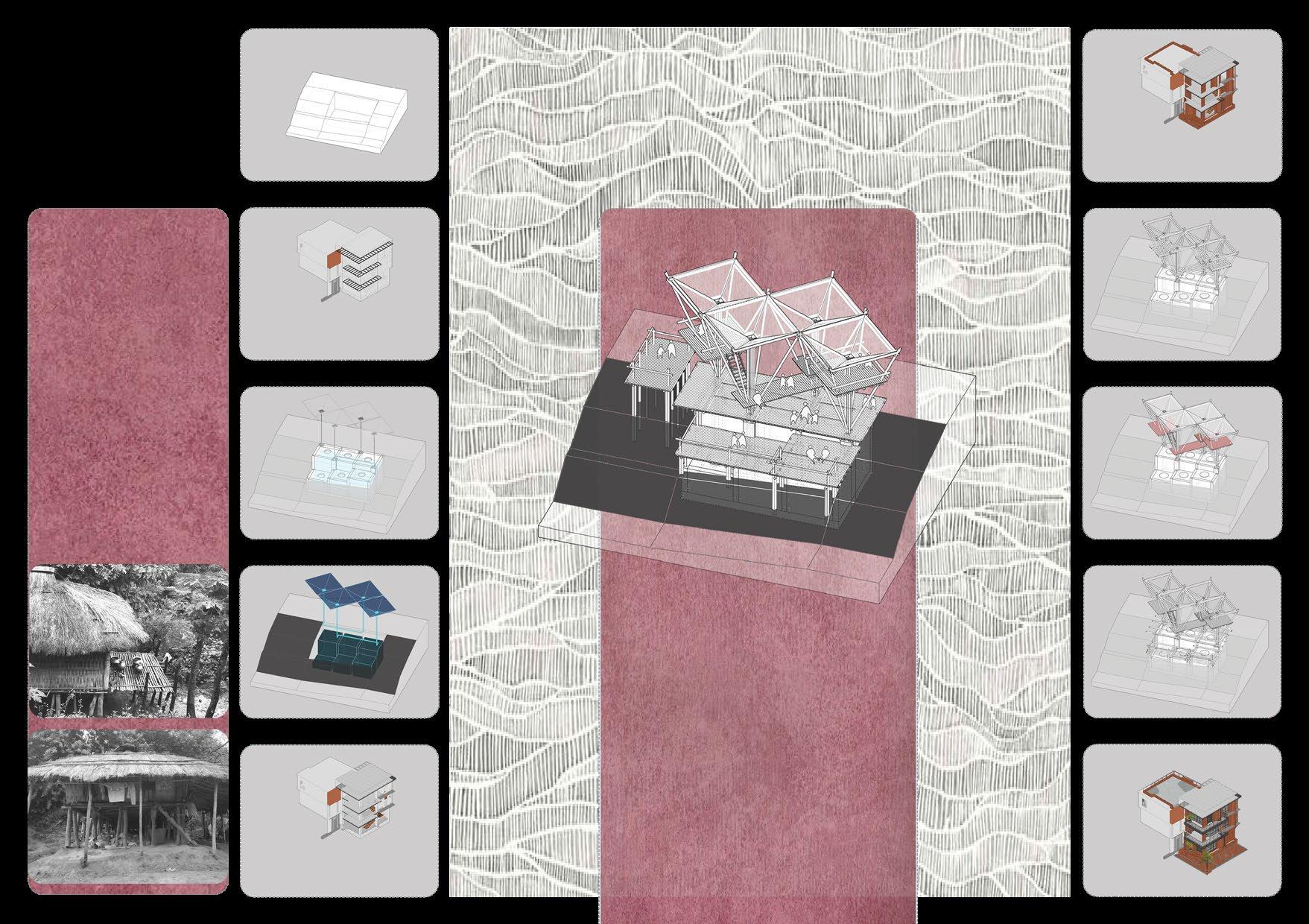
Visiting a site, almost 400 km from the captial, only approachable by hilly trails, eventually led to discovery of newer knowledge of vernacular materials and making methods. Study and analysis of the local built form helped to opt for a design solution more contextual and community friendly.
The design proposed a RETAIN WALL in the eroding face of the ditch with stepped BUTTRESS WALL to prevent soil erosion in the first place.
This partition walls created six (6) CHAMBERS in between which can now be used as water reservoir with proper plumbing solutions.
To collect the monsoon rain water Four (4) Rain catchers were installed which can be used to drain water to the reservoir tank.
The lower chambers were connected with upper chamber with control vaulve to prevent overflow of the water
Each Raincatcher was design as an inverted pyramidal form to transmit load in an anchore point. Each anchore point was inserted in the metal hook placed with concrete casting of the retain walls
Total covered ground : Approx. 240 sft
Water Storage capacity Approximately 11000 litre
The rain catcher was designed as a collection of four upturned pyramidal funel which are supported by bamboo columns. This is the most visible part of the project above the ground level. Mostly made out of bamboo, a locally available resource, the rain catcher creats a sense of roof plane over the reservoir tank.
Polycarbonate sheets cover the upturned pyramidal funnel’s inner faces to prevent rainwater leakage. A custom iron funnel connects the polycarbonate sheet to the water collector pvc.The reservoir tank is connected to the collection pipe by each verticl bamboo column’s hollow space. Diagonal bracings and horizontal connections give the superstructure visual unity and provide lateral support.
Four similar form with interconnected bamboo members created a stable three dimensional lattice work. This whole bamboo structure was capable of taking considerable live load.
The bamboo skeleton also accomodated multi-leveled bamboo platform offering a playful space for the children
Those platforms were connected with the inclined bamboo ladders creating a risk taking playful movements .
Bamboo platforms were also constructed over the lower staggered chambers to enhance the playscape and activity generating facility.
In the last phase, the top surface of the reservoir tank was covered with deplyable Bamboo mancha which can easily be removed reshapede or replaced for easy maintenance.
MAKING: CO-CREATING
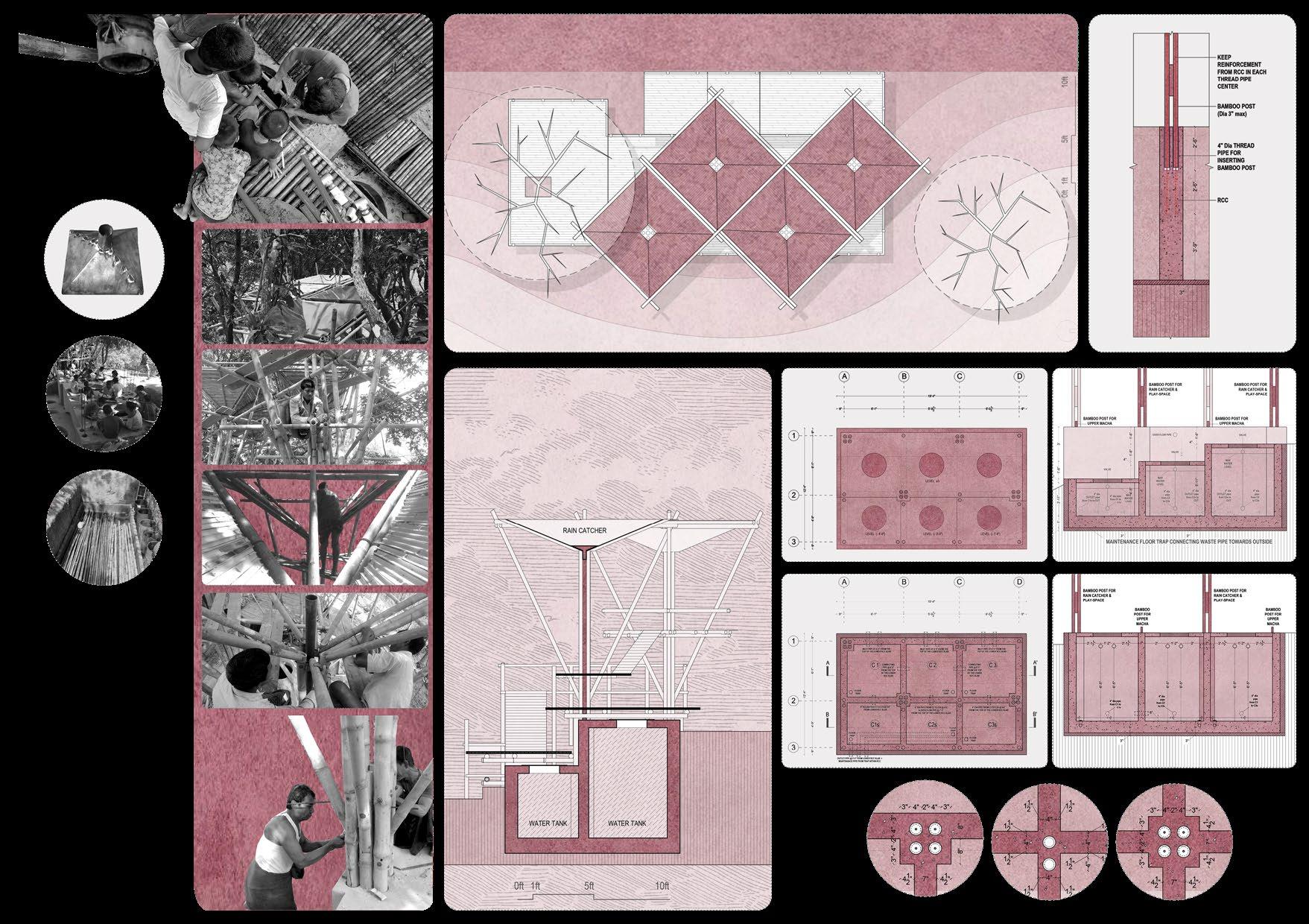
The artisans, the community, the kids, the design team beautifully amulgamated during the construction.
The project ultimately became a tool for knowledge sharing with the community. Learning about their rich vocabulary of materials and resources of methods, evantually led the design team work hand in hand with them. The top down approach was deliberately avoided. Even the kids sometimes help the construction process by carrying light weight childrensafe tools. They watch the reservoir and the bamboo rain catchers being constructed by their own community, which ultimately initiate the belongingness to the playscape long before it was completed. The kids and the community started to use the platforms even before full completion.
THE HAPPY FACES !
The outcome was more than expected, with the kids running and climbing to and fro from one machang to another machang, inventing interesting games and activities. Beyond our prior speculation, the kids began to even use the platforms for their other daily activities : dinning under tree shade on a sunny day, preparing the food sitting there, even on some school days, the platform beagn to be used as open classrooms.
The community was happy as well, they warmly accepted the infrastructure as it never seemed non native in course of materials and appearce, yet the final formal expression created a new landmark identity, for making memories of their community life.
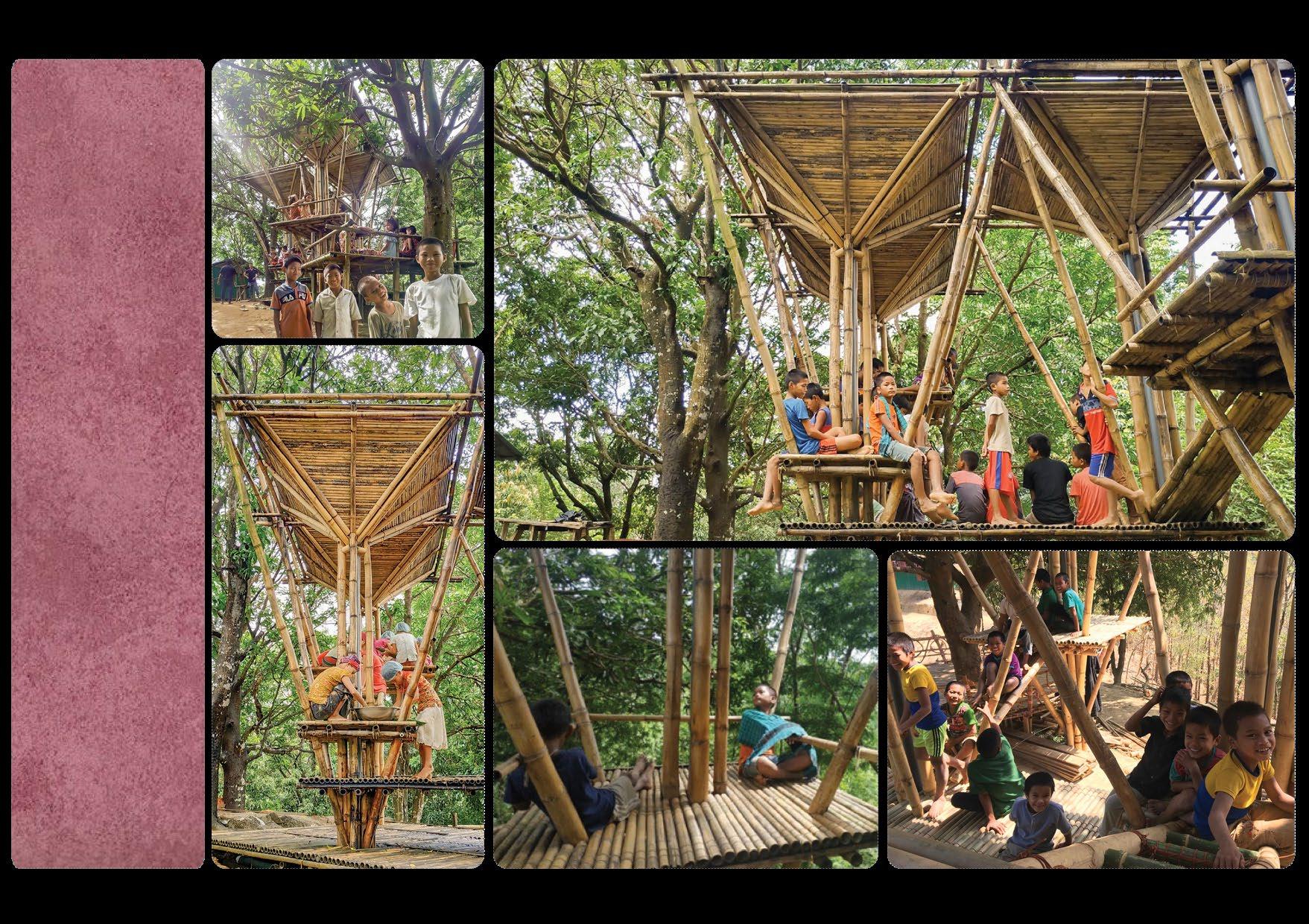
Water clogged land with illegal sewarage oulets in the land, disastering ecology
FROM WATER CLOGGED INTO AN URBAN PARK

The site was a “khash Jomi” (Govt. Owned Land) which had for a long time remained abaondoned. The context was a suburban one, being recently transformed into a future transportation hub, anwara has seen the impact of urbanizaton more than before in the recent days. The surrounding site was occupied by residential buildings, lacking proper central sewarage system. The abandoned site was being illegally used for dumping sewerage water from the lacolity, creating water clogging, odor and mosquito nuissance and environmental degradation.
The initial proposal addressed the sewerage issues by introducing proper drainage and reclaiming the green space. The green space was later perceived as a public amenities hub. With analyzing the surrounding township, possible program were listed and discussed with the policy makers. Rather than incorporating large scale interventions, the future proposal adopted to conceptualize the public space as landscape event, keeping the green areas mostly open and compacting the other facilities to a minimum footprint. The morphology of the newer built masses were conceptualized as part of the environmental ecology, ultimately leading to pavilion type compact structure. The incorporation of a retaining rain water pond ensured no further clogging in the wet season, while the choice of vegetation layers deliberately adopted to re-infuse the native flora and fauna, aqautic species, local fruit and flower trees were sourced and planted to revive the local micro-ecology.
Construction Completed 2022
Architectural Firm : Chorcha Sthapatijog
Team Work
Contribution to Team: One of the Principal Architects Design Decisions, Co-ordination, Construction Drawings
Reclaiming the open green, re channeling the sewarage system, connecting it with under road drains,
Making the reclaimed green accessible to public by introducing walking trails, with central rain garden for drainage and aquatic ecosystem.
Re incorporating local flora fauna aiming symbiotic ecosystem
Incorporating and introducing newer public amenities, from local landuse analysis and requirement.
Children Play area, Walking trail, Food Facility, Service Facilities aiming an symbiosis of public space, amemities and Environment.
NEAR ANWARA LAND OFFICE, ANWARA UPAZILA, CHATTOGRAM, BANGLADESH
AKHTARUZZAMAN CHOWDHURY BABU SMRITY PARK
FOR NARIKEL, SUPARI, TAAL CENTER TO CENTER DISCTANCE SHOULD BE MINIMUM 6’
BIG TREES CENTER SHOULD BE MINIMUM 5’ OFFSET FROM THE PAVE CASTING AREA
FOR NARIKEL, SUPARI, TAAL CENTER TO CENTER DISCTANCE SHOULD BE MINIMUM 6’
BIG TREES CENTER SHOULD BE MINIMUM 5’ OFFSET FROM THE PAVE CASTING AREA
FOR NARIKEL, SUPARI, TAAL CENTER TO CENTER DISCTANCE SHOULD BE MINIMUM 6’
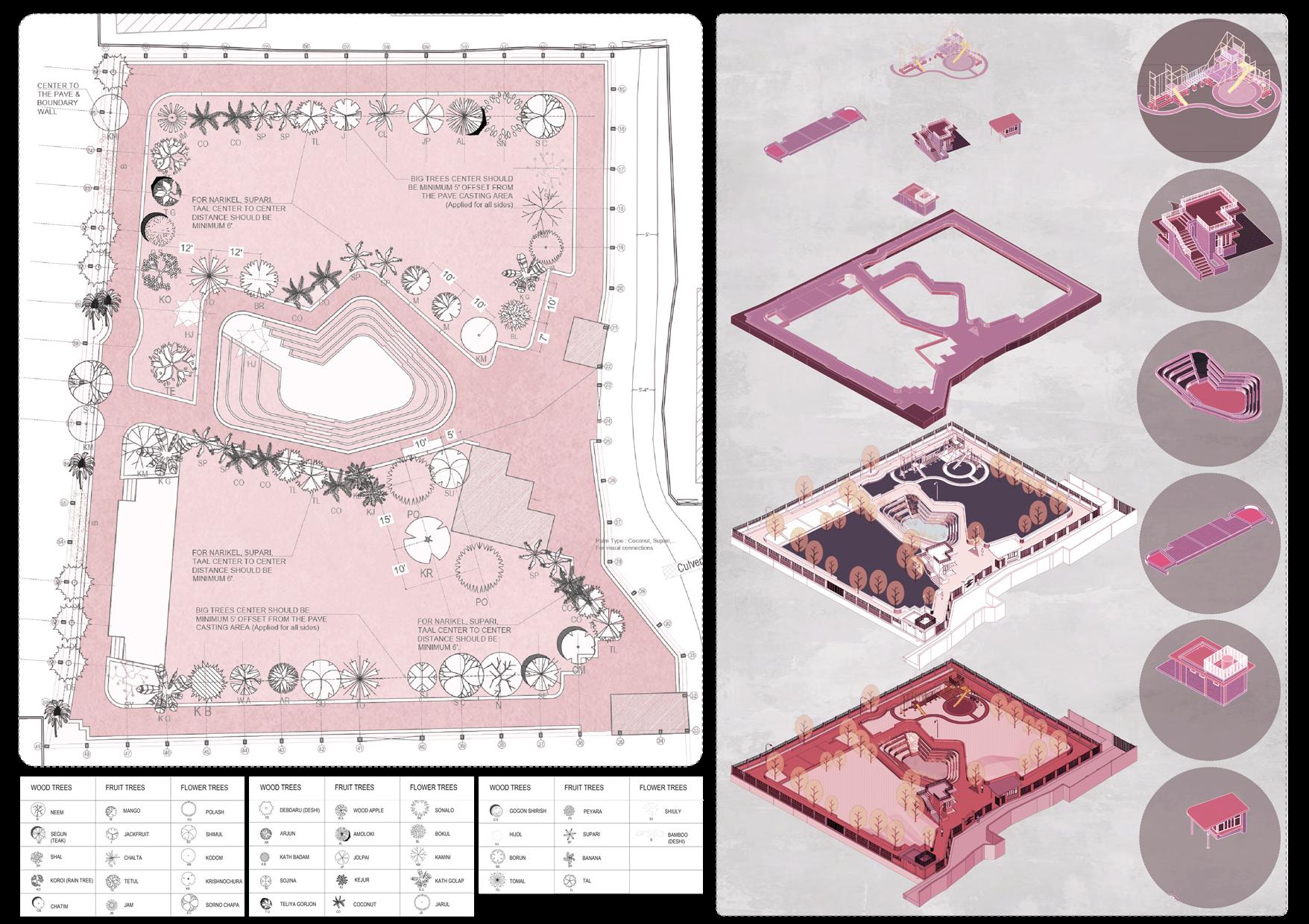
AQUATICSHRUBS AQUATICSHRUBS
6. SECURITY DESK
3. RAIN GARDEN 4. OPEN AIR STAGE 5. WASHROOM
BUILT
1 2 3 5 4 6
2. FOOD ZONE
WALKWAY
& WALL SEATING
MASSES
1. PLAYSCAPE
CENTER TO THE PAVE & BOUNDARY WALL LANDSCAPE PLAN NEEM SEGUN (TEAK) SHAL KORI (RAIN TREE) CHATIM JAM TETUL CHALTA JACKFRUIT JACKFRUIT MANGO POLASH SHIMUL KODOM SOJINA KHEJUR COCO NUT JARUL KATH GOLAP TOMAL KAMINI BORUN BOKUL HIJOL SONALU GOGON SHIRISH PEYARA (GUAVA) SUPARI BANAN TAL (LOCAL PALM) LOCAL BAMBOO FLOWER TREES FLOWER TREES FLOWER TREES FRUIT TREES FRUIT TREES FRUIT TREES WOOD TREES WOOD TREES WOOD TREES SHEULI KATH BADAM (CHEST NUT) JOLPAI (OLIVE) ARJUN AMLOKI DEBDHARU (LOCAL) WOOD APPLE KRISHNOCHURA SHORNOCHURA TELIYA GORJON
PLAYSCAPE DETAILS
The playscape design prefered the use if locally sourced materials for future sustainability, emphoasizing multifarious play possibilities for the kids of different ages.
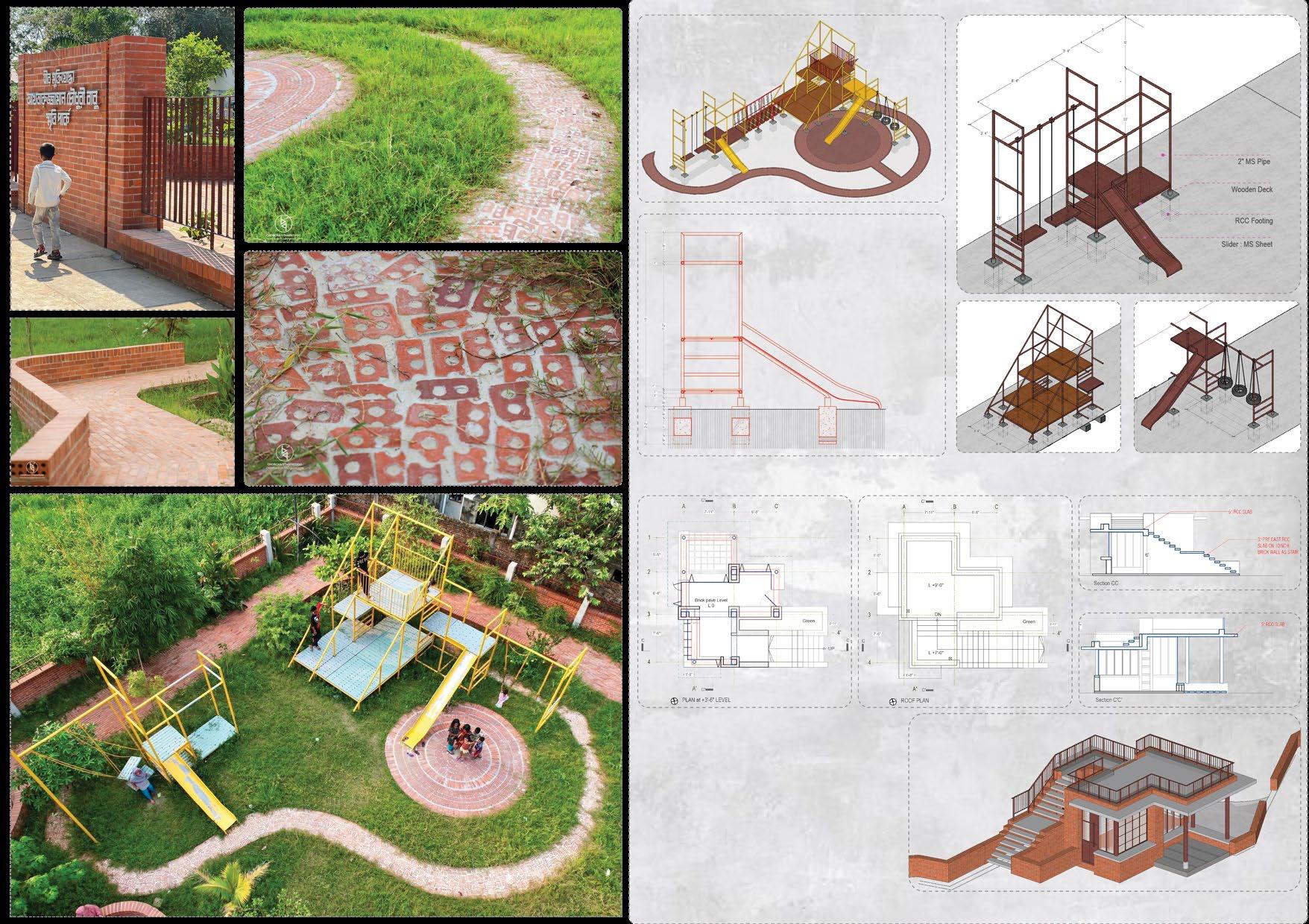
FOODSCAPE DETAILS
The formal expression of this large built mass deliberately preferred to be ambiguous, it apprears as more of a plublic stair rather than a building, the service are compactly hidden beneath the roof shed, with the mass connected to all of its sides.
2” MS Pipe Wooden Deck 5” RCC Slab 3” precast RCC Stair on 10” Brick Wall Section CC 5” RCC Slab
Brick
RCC Footing MS Sheet Slider
Section C’C’ Roof Plan Plan
at 3’-6”
Pave
RAIN GARDEN DETAILS
The rain garden, the heart of the park, simultaniously work as a retaining water body during the monsoon , while accomodating a number of low maintenance aquatic flower plants. It provides with the scope for a micro ecology of insects, flora and fauna The reatining walls are staggered and stepped , creating space for seaating at intervals, the water channels hidden in the green fields are coonected to the bottom the rain garden, ultimately connected towards a outlet to address the issues of water clogging during excessive rain.
Boundary Column
Metal Grillage
Capping Beam
5” Brick masonry
Herring-Bone Pave
Electric Conduits
3” CC Casting
3”
3” CC Casting
5” Brick Cladding
Herring-Bone Pave
Shade Light
Electric Wall Conduits
Electric Conduits
3” CC Casting
Grade Beam
Brick Footing
WALKWAY DETAILS
The walkways are designed for the experiential transition of the users, adopting a morphology of smooth curvature, that deliberately obscure the views at cardinal point providing a scope of exploration and curiosity. The sidewalls are thickened to be used as seating and resting space while walking. The loop can provide a number of track length due to the central connection with the periphery of the rain garden.
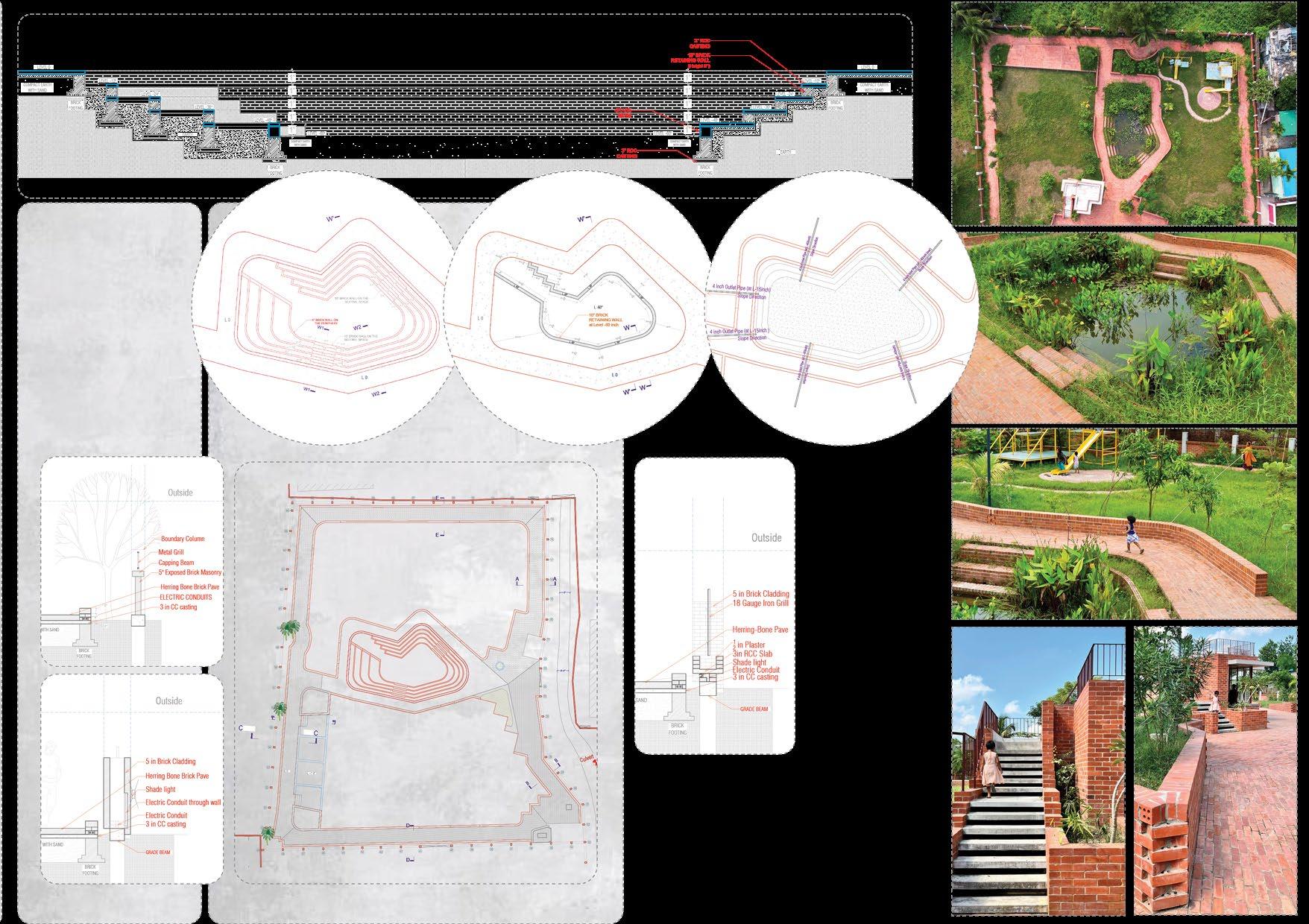
Herring-Bone Pave 18 gauge Iron Grill
5” Brick Cladding Shade Light Electric Conduits
RCC Slab 1/2” plaster Brick Footing Grade beam
9”) GRADE BEAM
CC Casting
CC
OUTSIDE 10” BRICK RETAING WALL AT “-60”” 5” BRICK PERPHERAL WALL 10” BRICK AT SEATING 10” BRICK AT SEATING OUTSIDE OUTSIDE Brick
Brick
Brick
Brick Footing Brick Footing SAND COMPACTION SAND COMPACTION 4”OUTLET PIPE @L-40” 4”OUTLET PIPE @L-15” SLOPE DIRECTION SLOPE DIRECTION SLOPE DIRECTION SLOPE DIRECTION SLOPE DIRECTION SLOPEDIRECTION 4” OUTLET PIPE @L-15” 4”OUTLET PIPE @L-40” 4”OUTLETPIPE@L-40” 4”OUTLET PIPE @L-40” EARTH EARTH
10” BRICK RETAINING WALL (HEIGHT
3”
3”
Casting
Footing
Footing
Footing
URBAN OASIS WITHIN A COMMERCIAL TOWER : DESCO HEAD OFFICE
New Airport Road, Nikunja, Khilkhet, Dhaka, Bangladesh
The uniqueness and contribution of DESCO, the country’s leading energy regulatory organization, demands the challenge of making an identifying, bold, and statement-oriented physical entity. The design of the project intends to meet the demand and explore a new approach to visualizing a corporate icon.
The design evolved around a central courtyard - a place attracting and accumulating people sharing the festivity, unifying the commonalities, strengthening the corporation into a tight urban enclave-where the drama of hori-zonal arrangement experiences in to vertical staggering, free flowing spaces, inter level physical connections, windering bridges and sculptural framing of the sky ensures the feeling of being together. The changing mood of daylight and its various patterns throughout the whole year have been an integral part of the composition of the main building facade. The building stands out of firm base, evokes from the ground, becomes light as it grow up and floats as it reaches its top. The manicured garden at the top level offers a corporate crown within a busy urban context. While developing the design, there were three different scales in the play.
The first is the urban scale that connects the building to the busy highway in front of it or the airport area as an urban icon. Second, the neighboring scale connects the building to its neighbors, who live with it every day. The DESCO self-corporate identity scale is third. The building’s expression was all three scales. Each floor was designed to create a large, uninterrupted horizontal space for the entire office under a roof. The uniform column layout with a large span gives the office space maximum flexibility, energy efficiency, building support system optimization, and optimal car parking, which improves the building’s operation and central maintenance. The elegant building’s interior, with its high ceiling, inner walls, exterior glass surface, and climatic responsive fins (lamella), creates a subtle and ample ambiance, enhances the space, and transcends into a higher dimension. The loft’s central courtyard, bridges, and Airport Road views create a human-centered environment for workers. The exterior facade, glass, interwoven bridges, deep recess, ground promenade, and structural beauty create a sculptural landmark.
Competition Winning Entry, Selected for Constrcution Competition Timeline : 2016
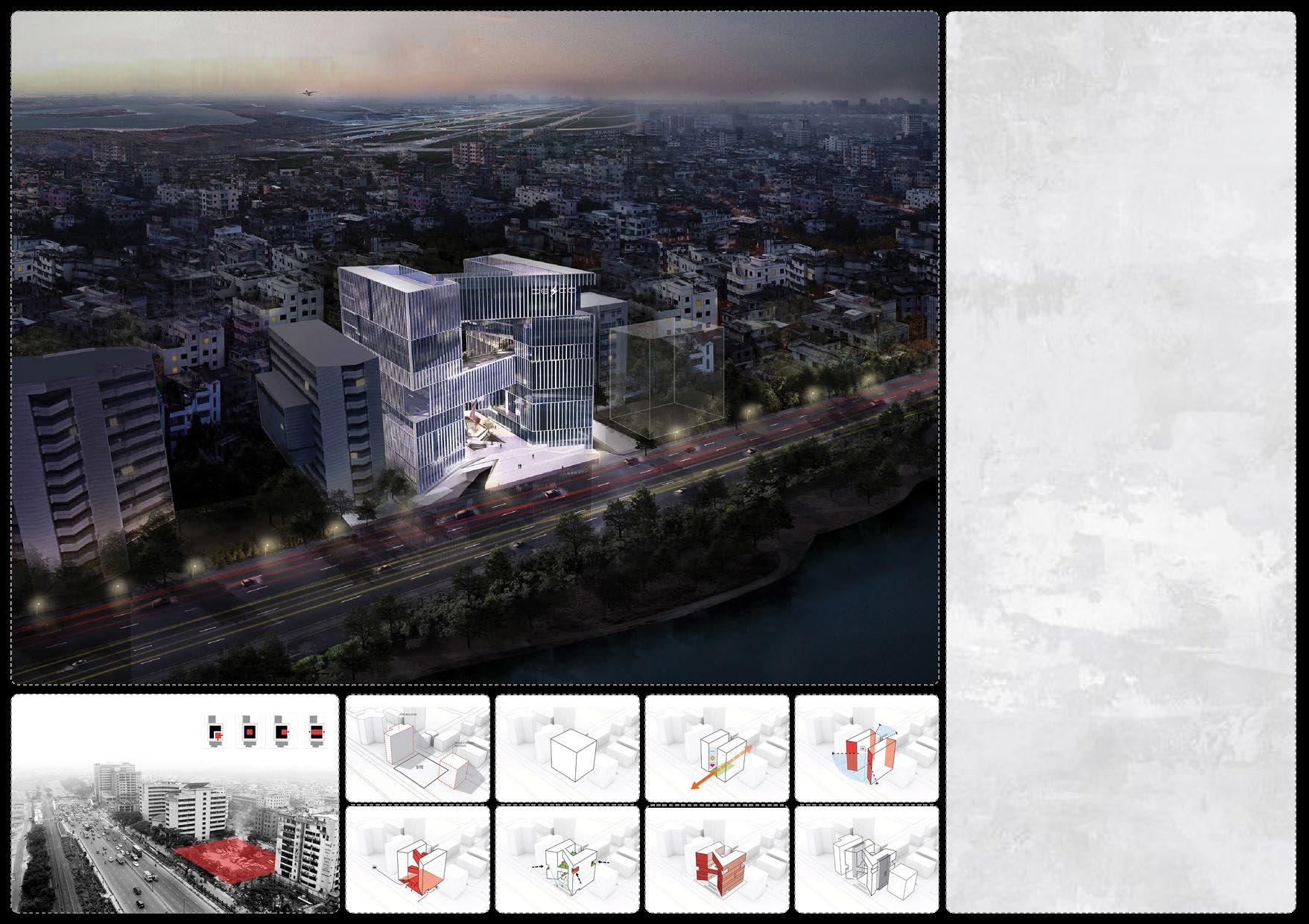
Construction On-Going
Architectural Firm : Roofliners-Studio of Architecture
Team Work
Contribution to Team:
Design Team member, Competition Phase Project Architect (2017-2020), Constrction Phase Design Decisions, Presentation, Collaboartion with Other Consultants, Construction Drawings Preparation
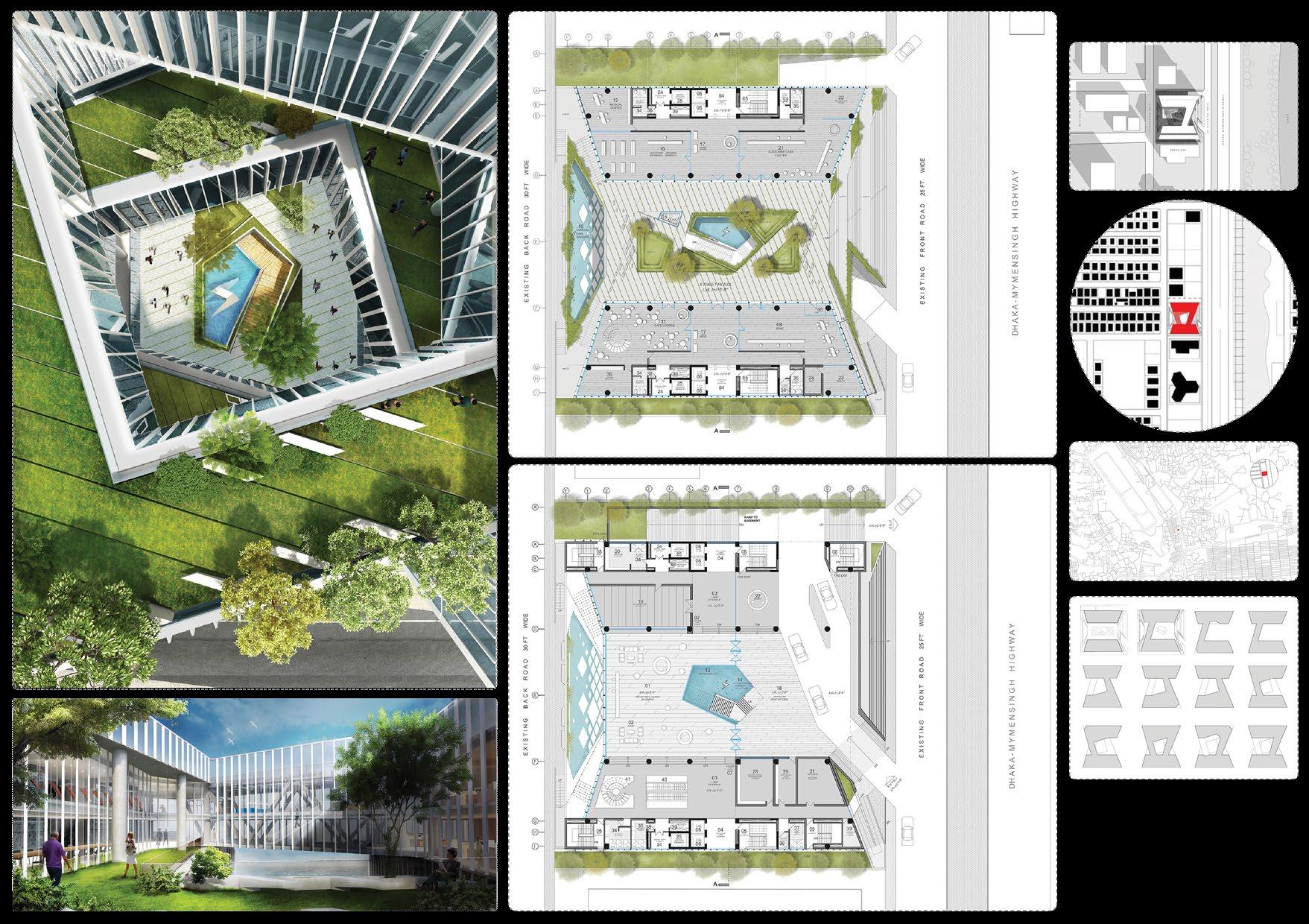
PLAN LEVL 01 : THE URBAN PLAZA PLAN : LEVL 00 : THE TOWER LOBBY EXISTING FRONT ROAD 25 FT WIDE EXISTING FRONT ROAD 25 FT WIDE DHAKA MYMENSING HIGHWAY DHAKA MYMENSING HIGHWAY
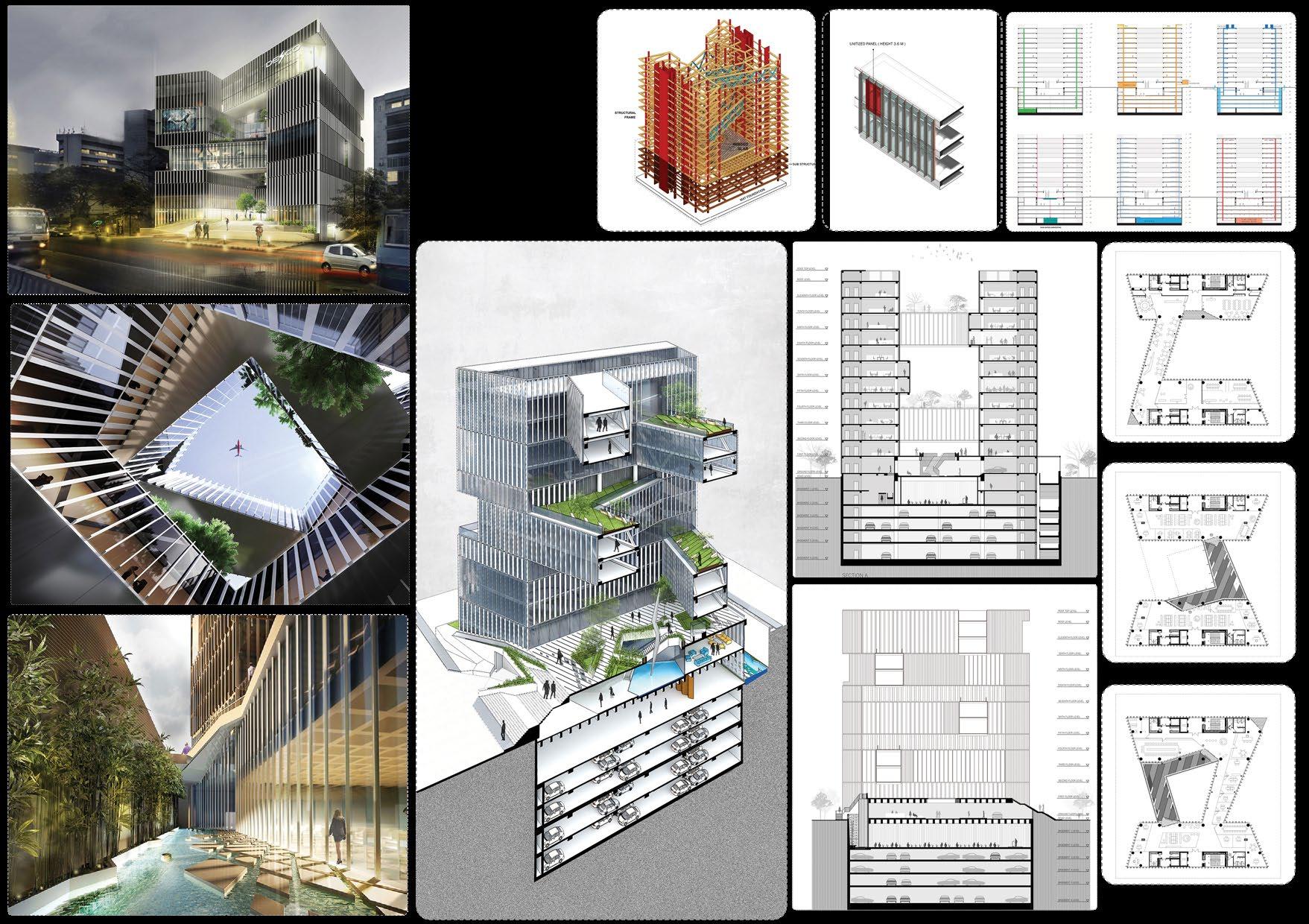
PLAN : LEVEL 07 PLAN : LEVEL 10 PLAN : LEVEL 02 UTILITIES
SECTION
AND ROAD CONNECTION
SECTION THROUGH THE TWO TOWERS
THROUGH PLAZA
THE GREEN SPRIALS : SECTIONAL AXONOMETRIC
FACADE SYSTEM : UNITIZED PANNEL STRUCTURAL SYSTEM
SITE PREPARATION & SHORE PILING
Terrace Details : Level 10
DETAILS : GREEN TERRACE ON THE BRIDGES
REFLECTING POOL
Terrace Details : Level 7
Blow Up 1
SUBSTURCTURE TOP DOWN METHOD
Refelected Pool Plan
Refelected Pool Blow Up 1
Sculture : Elevation
SUPERSTRUCTURE
FACADE INSTALLATION
CONSTRCUTION PROCESS
DESCO Head Office consists of 12 stories with 6 basements. The latest top down construction method is used for the building. Alternate floors from the top are constructed first without excavating up to approximately 65 feet so that the surrounding buildings are not hampered. Then the ground floor and the rest of the floors are constructed in ascending order. The connecting bridges are constructed after all the floor slabs, columns, and beams. These pre-fabricated metal structures are made at different workshops simultaneously with the building construction so that the total construction time is decreased. After all the civil construction works are done, the façade glasses and lovers are assembled to complete the building The construction technique of this building is expected to be a milestone in Bangladesh.

Sunken Court Plan Sunken Court Section
DETAILS
THE BASEMENT 50mm gravel 50mm gravel floor mounted spot light floor mounted spot light 100 mm RCC lowWall 100 mm RCC lowWall 100 mm RCC low wall tapped with 18mm granite 100 mm RCC low wall tapped with 18mm granite 100 mm RCC low wall carpeting grass carpeting grass drain topped with 38mm granite drain topped with 38mm granite seating seating 12 mm tempered glass railing 12 mm tempered glass railing garden light garden light halogen light halogen light floor trap floor trap 10mm glass partitiion water proof light bubble fountain water body 25 mm glass wall floor finish outline drain sculpture spray fountain precast planter box precast planter box 18 mm thick granite 18 mm thick granite 10 mm thick granite
CONSTRCUTION
CONSTRCUTION DETAILS :
CONSTRCUTION
: SUNKEN COAURT AT
MIRZA BARI : VILLAGE HOME RETROFIT AND REFURBISHMENT
MADARGANJ, JAMALPUR DISTRICT, BANGLADESH
The project was completed in a suburban region where individuals construct structures without the assistance of an architect. As the heir to his parents’ home and one of eight siblings, he sought to expand his portion and hired a local mason to construct a beam, column, and slab. Eventually he realized that he was unable to make it functional and was unsure whether he should dismantle the entire structure in order to achieve adequate natural light and ventilation.
When the client came to us, we took few decisions methodologically, as we also had to complete the retrofitting work, exterior outlook and interior refurbishment within eight months.
Firstly, we expanded shaded areas in the west and south retrofitting the structures considering the essential climatic considerations (sun and rain) of our region; for this, we provided large openings for proper lighting and ventilation in the house’s double height living room, dining and family space. Then we converted the shaded slab to usable large common varanda. For designing the exterior view we used low-maintenance materials and attempted to experiment with the modular nature of the bricks. We tried to devise a blend of ancient classical style with a touch of contemporary design to give the client the feeling of living in his village home. We transformed the interior of the ancient structure in light hues so that it may be well-lit even with the low light it receives from the east, as we were unable to modify the eastern portion of the structure because it could have an adverse effect in the future. Throughout the day, the curved brick walls play with the sun’s light, and at night, the entire home serves as a lamp for the compound. This project was effective in informing the public that it is not always required to demolish an entire structure and build a new one; rather, minor adjustments with delicate crafted touch as an architect in accordance with fundamental climatic considerations can create a solemn atmosphere for both clients and surroundings.
Construction Completed
2022
Architectural Firm : Plural Works
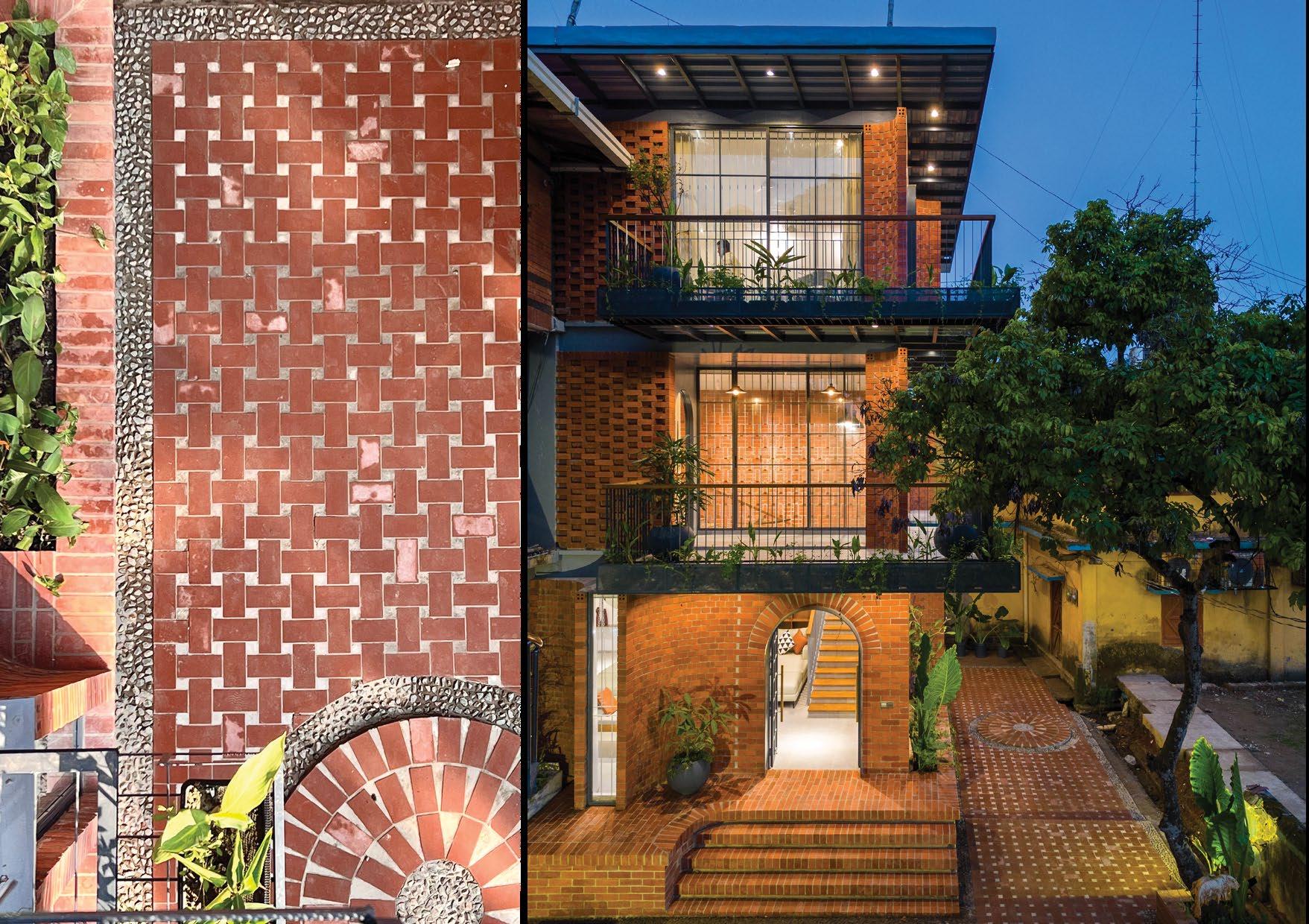
Team Work
Contribution to Team:
One of the Principal Architects Design Decisions, Render, Construction Drawings, Site Supervision

Old Block of almost 50years old
functional
value later Retrofitting and extension for extended
and varanda materializing the design decisions step by steps Site Location On Site Situation Ground Floor 1st Floor 1 0 2 3 4 5 7 8 9 9 10 12 11 11 11 7 7 13 7 6 2nd Floor 3. Dining 2. Family Living 1. Living Room 0. Entry 4. Kitchen 5. Service zone 6. Service Toilet 7. Toilet 9. Varanda 10. Corridor 11. Bedroom 12. Small Pantry 13. Roof Terrace 8. Storage
Client erected the structures of which he found least
and aestheic
shading
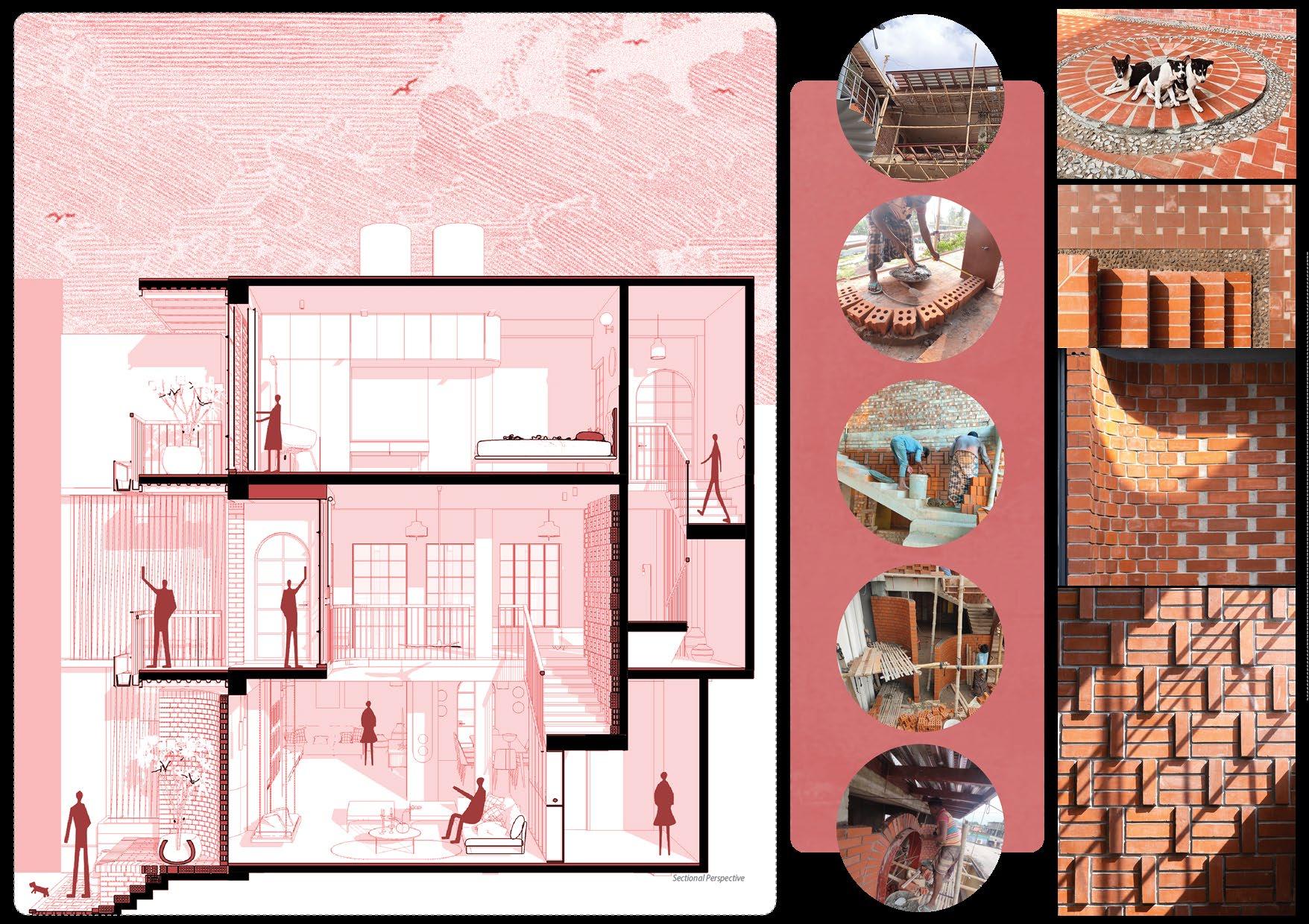
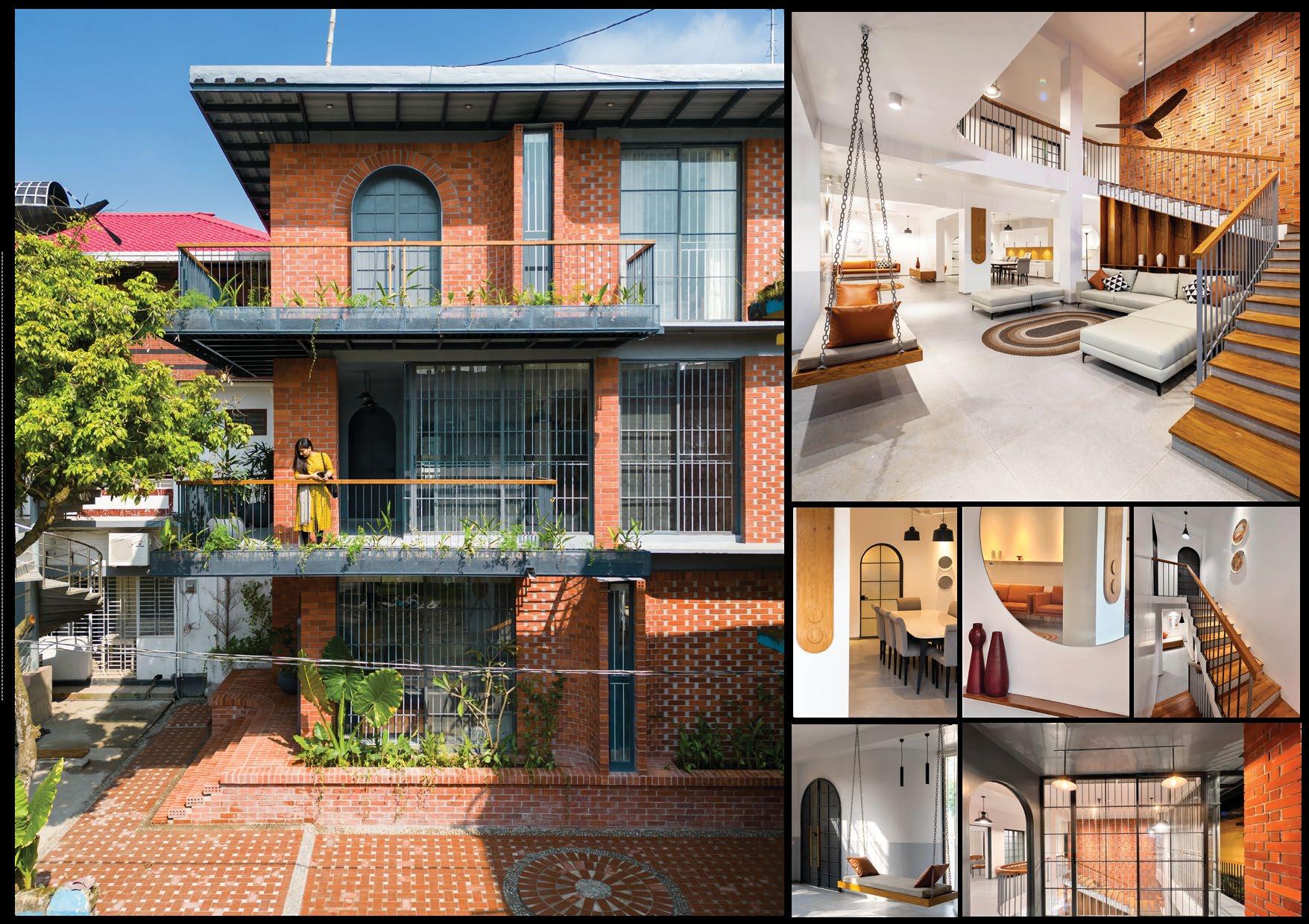
HANIRPAR
CENTRAL JAME MASJID COMPLEX AND ISLAMIC CULTURAL CENTER (HAMIC)
The masjid complex is located at the center of Hanirpar village of Neel Char Mouza in Chandpur district of Matlab Uttar upazila adjacent to Kalakanda Union Parishad. Adjacent to the onestorey mosque are Union Parishad, Union Health Center, primary & high schools, a dilapidated pond ghat, a shady Eidgah ground at Battala and a proposed madrasa.
Although men and women travel to this area on regular basis for the purpose of daily work and young boys and girls come every day for education, scope for praying here is extremely inadequate. Moreover, there is no scope for women’s prayer space.
At present, the AQS Trust has been teaching Quran and Arabic language to more than a thousand disadvantaged children in 20 maktabs considering the mosques as the central institution to influence the talent development of the promising children of this area.
Taking into consideration of the inadequate prayer arrangements and space for Islamic education, our firm has undertaken the task of expanding the mosque, keeping the arrangement for women’s prayers, an Islamic library, accommodation for imams and muezzins, office space, ablution space, washroom, and renovating the adjoining pond ghat within a very constrained budget. Till now 35% work has been completed. The remote location of the area, scarcity of an efficient labour force and the constrained budget limit are challenging us in every possible way.
It is dreamed that after completing the proposed aesthetic appearance of the mosque will enchant anyone spiritually and give the locals a wonderful alluring environment.
Construction On-Going
Starting Year - 2022
Architectural Firm : Plural Works
Team Work
Contribution to Team: One of the Principal Architects
Design Decisions, Render, Construction Drawings, Site Supervision

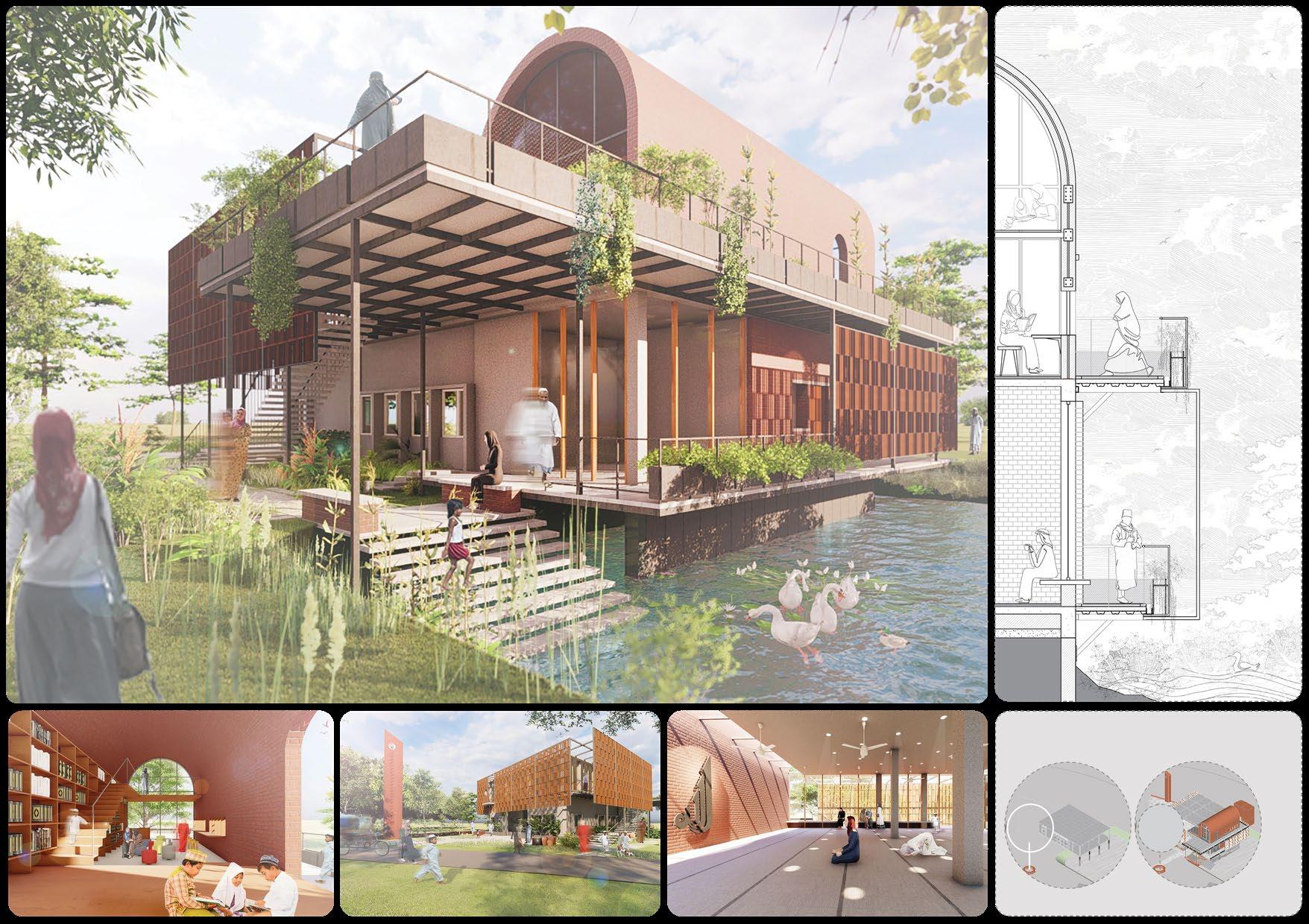
Existing Men’s prayer space
dia
Mezannine
Planter Box Metal Deck Sheet RCC Casting 4”x2” ms C channel
Bracketing: 4”x2” ms C channel
Render : Library Space Render : North-East View
Existing Situation Construction Phase 01 & 02
Brick 12mm
Beam
Concrete
Women’s prayer space Library Minaret Washroom Beam
Lintel Window Railing ms flat
bar
Seating
Render : Womens’ Prayer Space
Library/ Learning Vault
Existing Situation
Men’s prayer space
No Space for women
Neglected Space
Poor Washroom Facilities
Non Friendly Space for children
Deplorable Environment
Abandoned risky underconstruction site
PHASE 01:

Islamic Library
Office & Storage
Washroom
Ablution Space
Pond Ghat
Imam & Muazzin’s Accomodation Spcae
Wodden Jali, providing privacy to Women Prayer Space
Concrete roof over metal deck sheet
Transclucent corrogated sheet over stair
Light-weight Metal Beam
Book Shelf
Ablution Space & Toilet/ Upper Block (Women)
Operable Glass Opennings for Natural Light & Ventilation
Varanda Towards Graveyard Prayer Space (Women)
Mezzanine Floor for privacy of women
Library & Class Block
Open Terrace for outdoor learning
Phase 02:
Prayer Space for Women
Minaret An INCLUSIVE SPACE for all ages and gender ! !
Pathway Towards Ablution Space
Entry Stairs towards Library & women prayer space
Prayer Space (Men)
Ablution Space & Toilet/ Lower Block (Men)
Kitchen & Storage
Muazzin’s Room Storage
Imam’s Room
Office
60 years old Banyan Tree
Wodden Jali, providing privacy to accomodation block
Community Pond Ghat, Playspace & Seating

REMINISSANCING THE PAST : THE TROPICAL SHADE

Year - 2019
Design Team Lead, Design Decisions, Presentation Honarable Mention Winning Entry
International Design Competition By Pam (Institute Of Architects Malaysia) For The New Housing Module For The Indigenous Orang Asli People
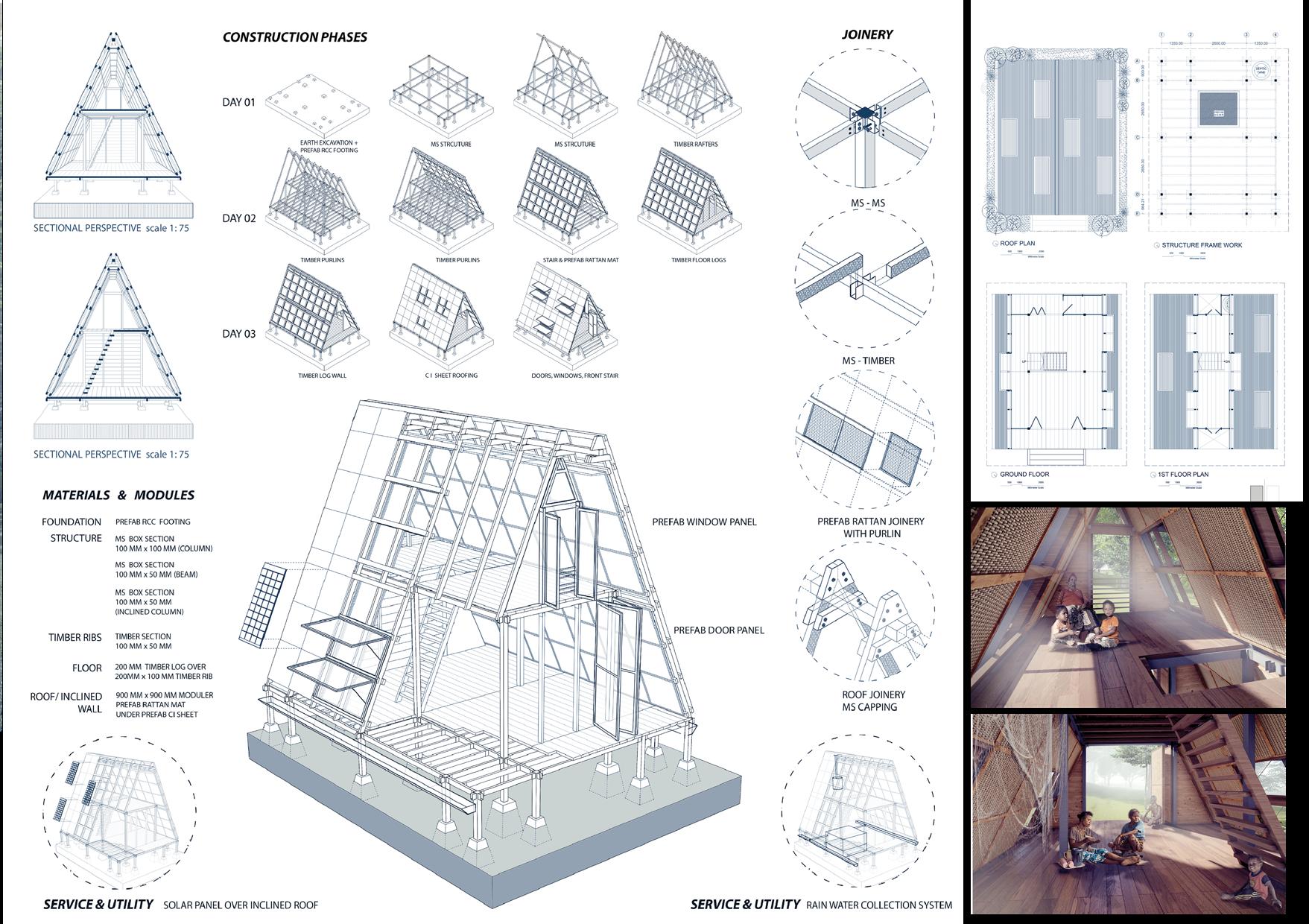
URBAN LOFT IN THE CULTURAL CORRIDOR
Open Design Competition by IAB for Coordinated complex of Public Library and Bangladesh National Museum
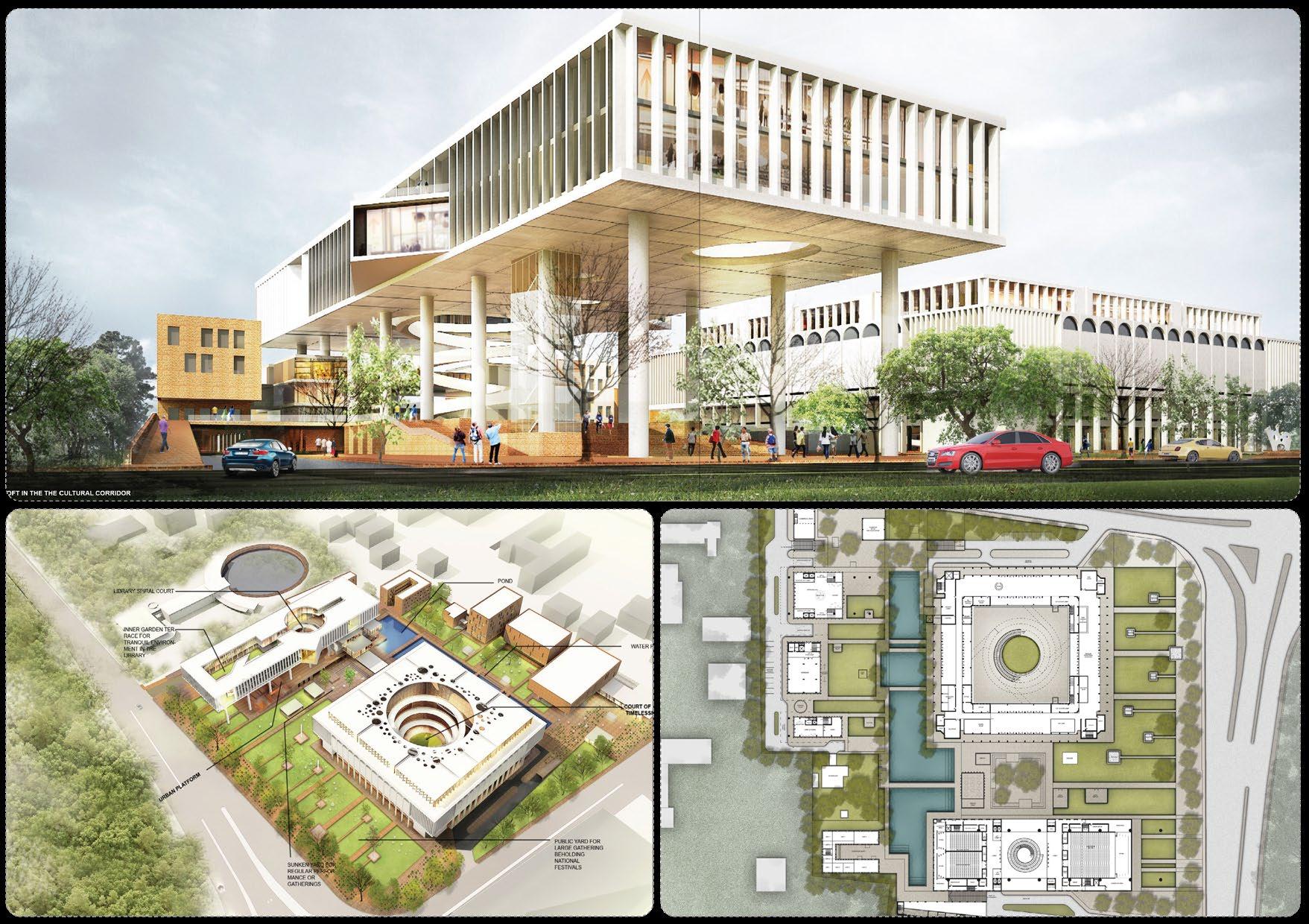
Honarable Mention Winning Entry
Starting Year - 2017
Team Work: Roofliners Studio of Architecture
Contribution to Team: Design Team Member, Design Decisions, Presentation

HEAD QUARTER : BANGLADESH ENERGY REGULATORY COMMISSION (BERC)
Special Mention with Commendation
Design Team Member, Roofliner Studio of Architecture.
Open Design Competition by IAB for the Head Quarter of Bangladesh Energy Regulatory Commission (BERC), 2018
HEAD QUARTER : NATIONAL HOUSING AUTHORITY (NHA )
2nd Prize Winning Entry
Design Team Member, Roofliner Studio of Architecture.
Open Design Competition by IAB for the Head Quarter of National Housing Authority (NHA ), 2018
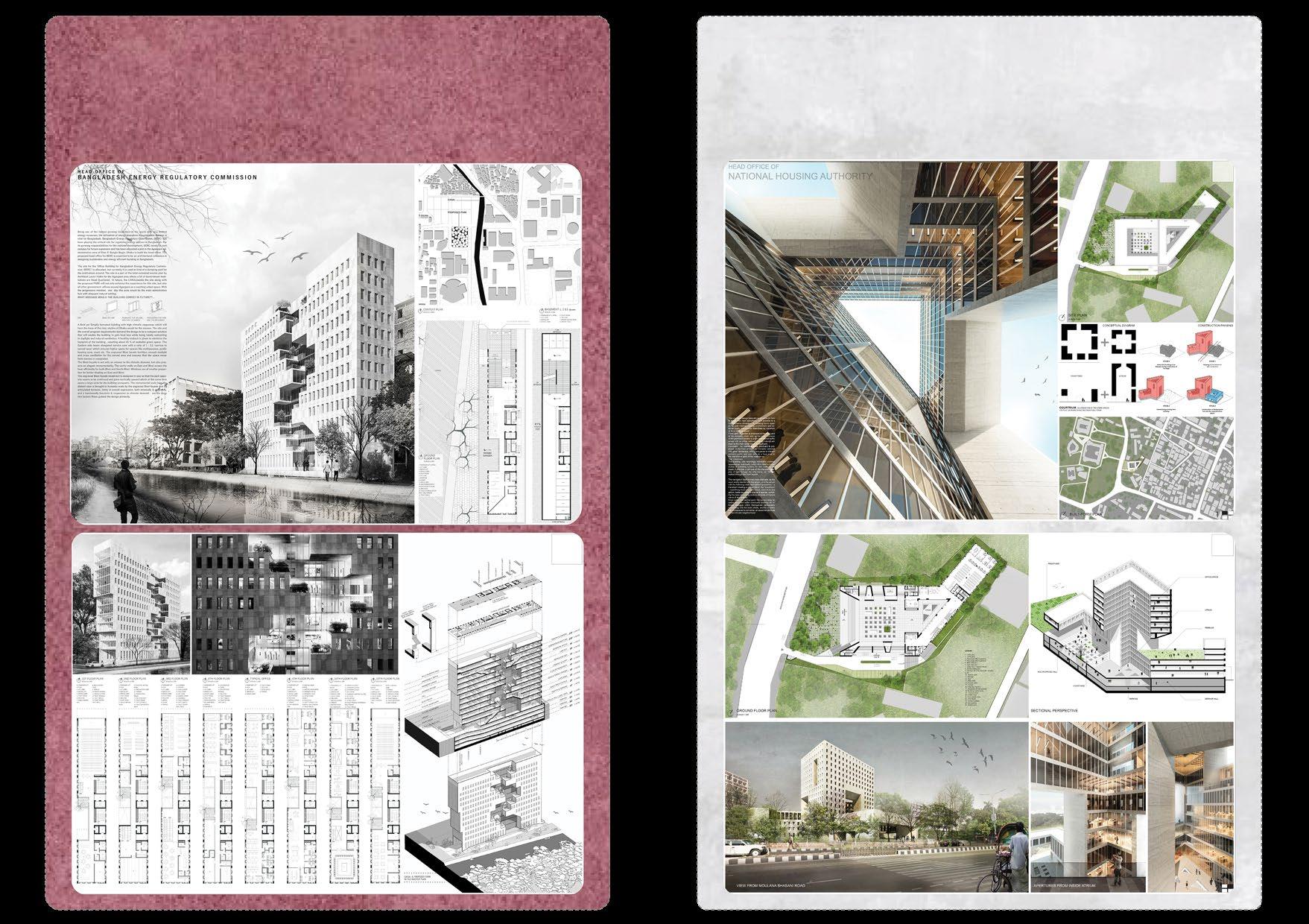
DESIGN RESILIENCE IN ASIA (DRIA)
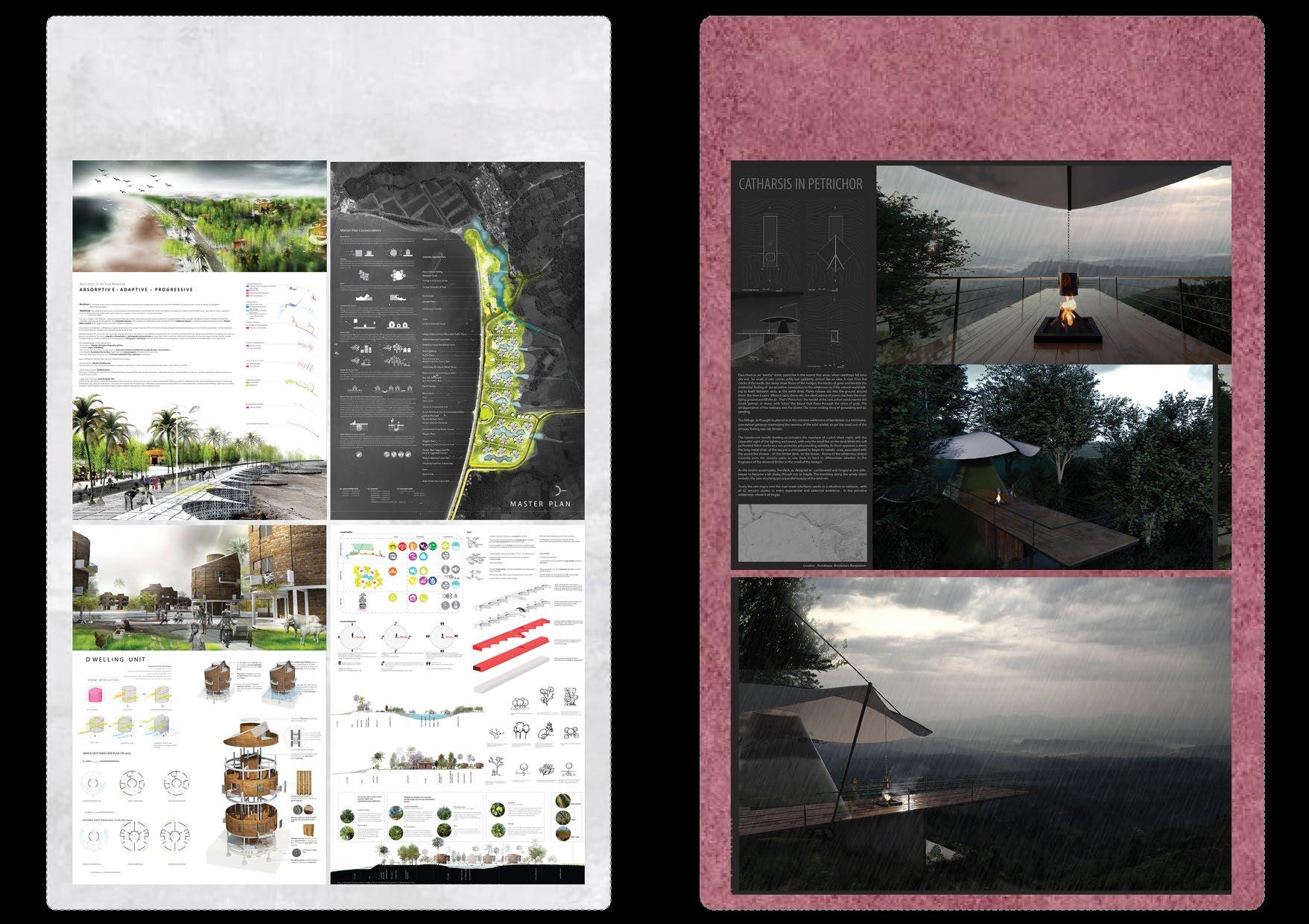
Top 15 Finalists
Team member, Selected team from BUET as Finalist for jury in Singapore for International Student Design Competition by Design Resilience in Asia, 2015.
ACCENTUATING RAIN
Special Mention with Commendation
Design Team Member, International Idea Design Competition Accentuating Rain By Achtwist 2018.








 THE “PROVAT FERI” AGE OLD PROCESSION CELEBRATING 21ST FEBRUARY, NTERNATIONAL MOTHER LANGUAGE DAY
THE COUNTER ASSEMBLY A DEMOCRATIC SPACE FOR CENGRESSION, IN FRONT OF SHAHEED MINAR, THE NATIONAL ICON FOR MOVEMENT AGAINST AUTOCRACY AND DISCREAMINATION
THE “MONGOL SHOVAJATRA” HERITAGE PROCESSION CELEBRATING POHELA BOISHAKH, THE BENGALI NEW YEAR
THE “PROVAT FERI” AGE OLD PROCESSION CELEBRATING 21ST FEBRUARY, NTERNATIONAL MOTHER LANGUAGE DAY
THE COUNTER ASSEMBLY A DEMOCRATIC SPACE FOR CENGRESSION, IN FRONT OF SHAHEED MINAR, THE NATIONAL ICON FOR MOVEMENT AGAINST AUTOCRACY AND DISCREAMINATION
THE “MONGOL SHOVAJATRA” HERITAGE PROCESSION CELEBRATING POHELA BOISHAKH, THE BENGALI NEW YEAR













 EXISTING FEMALE DORMITORY
HILLY TRAIL CONNECTING THE BUILT MASSES
THE LOCATION FOR THE INTERVENTION
EXISTING BOYS DORM
EXISTING FEMALE DORMITORY
HILLY TRAIL CONNECTING THE BUILT MASSES
THE LOCATION FOR THE INTERVENTION
EXISTING BOYS DORM

























